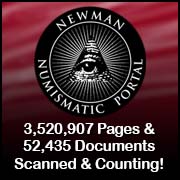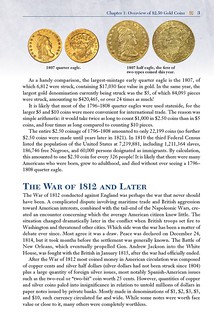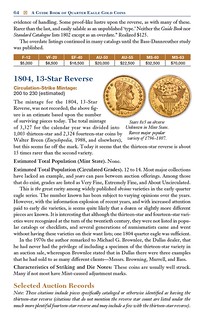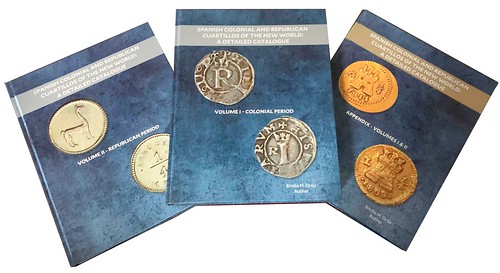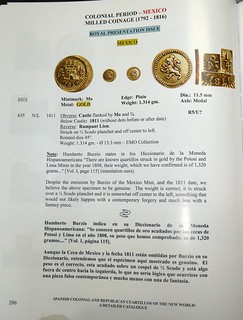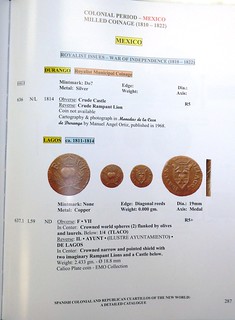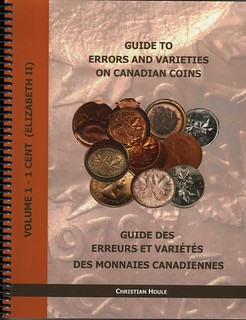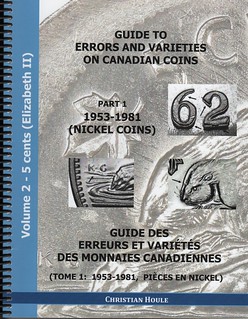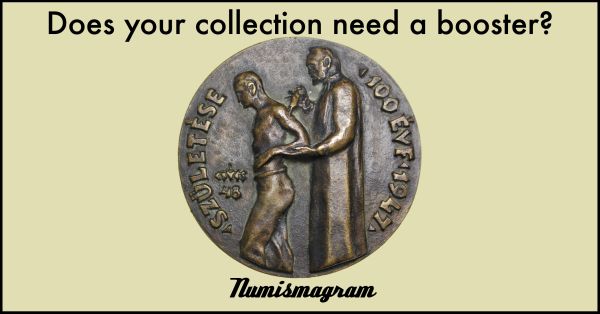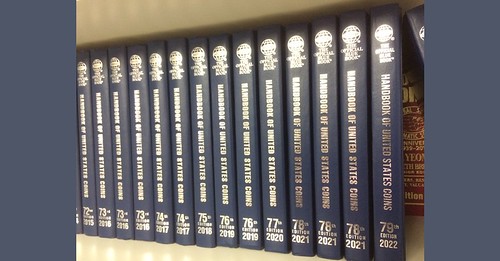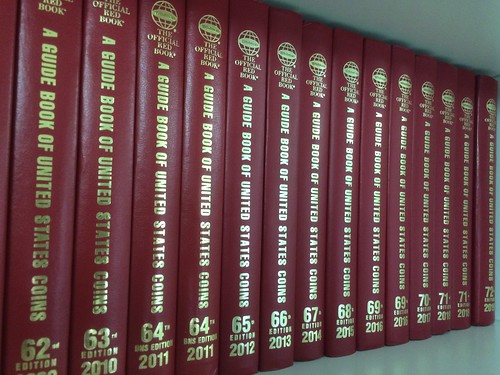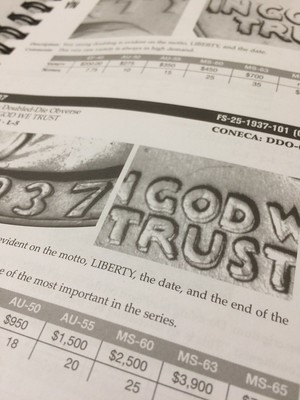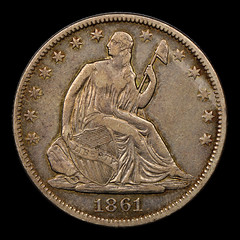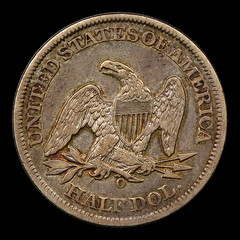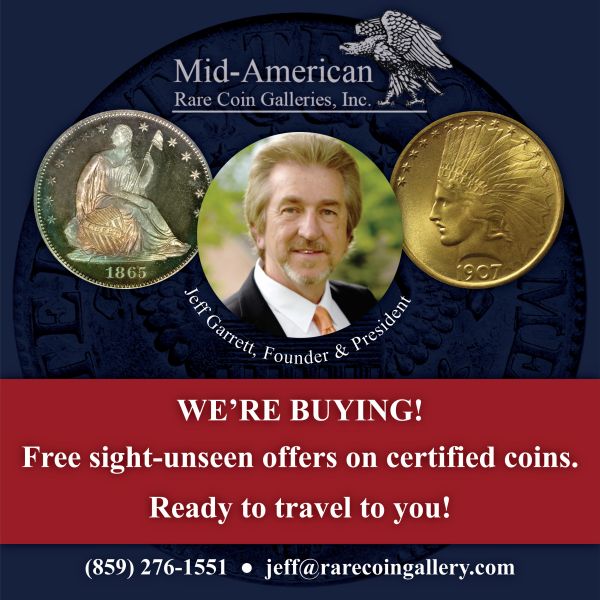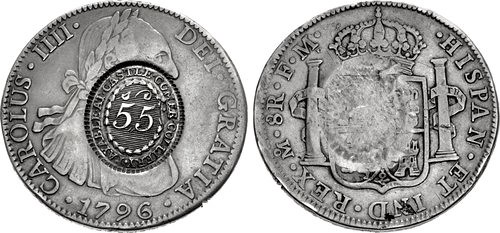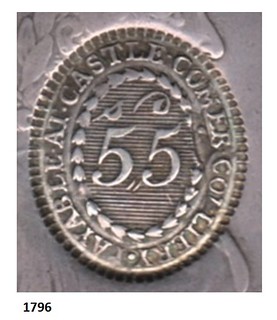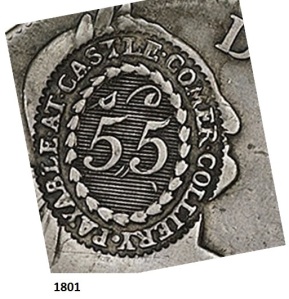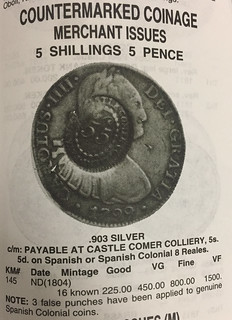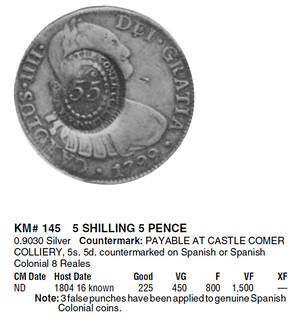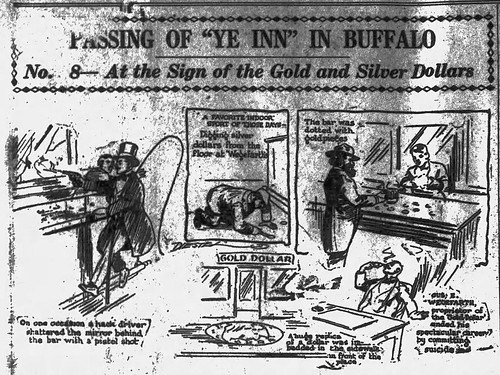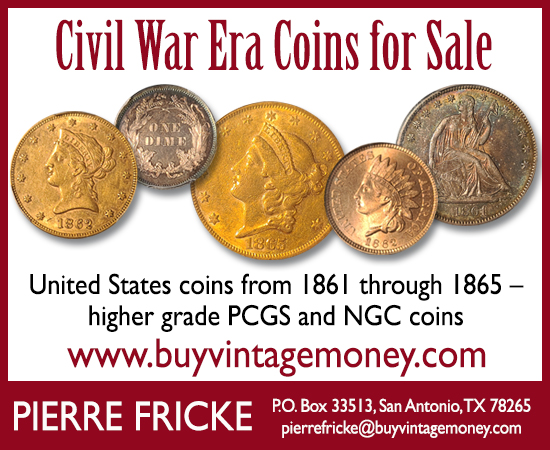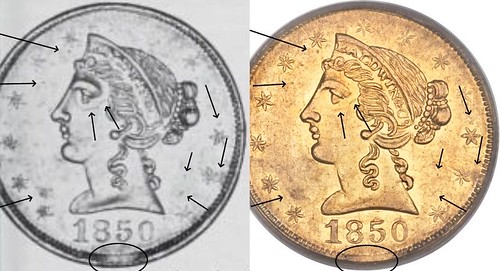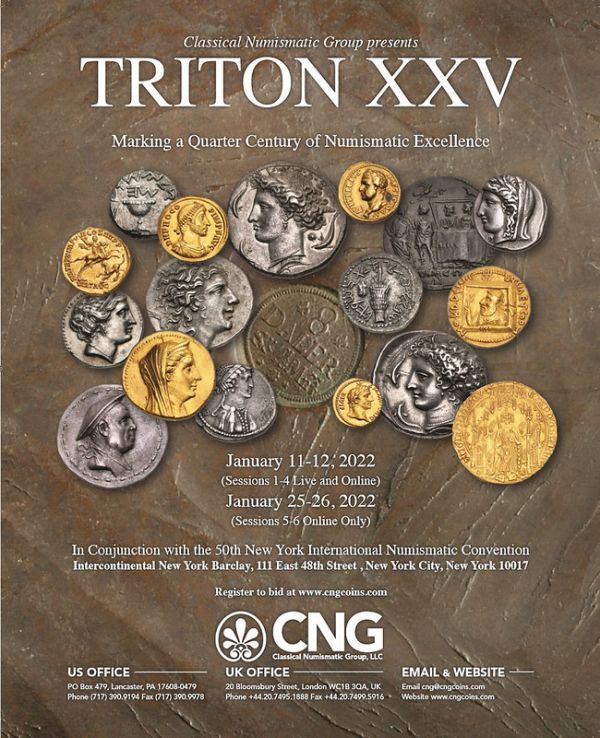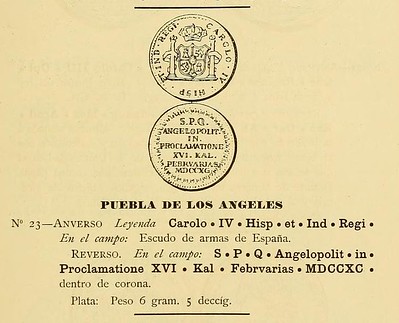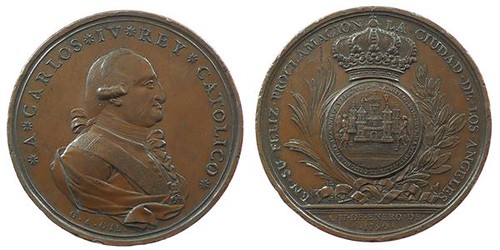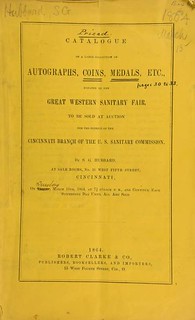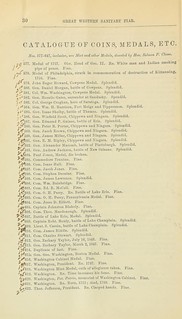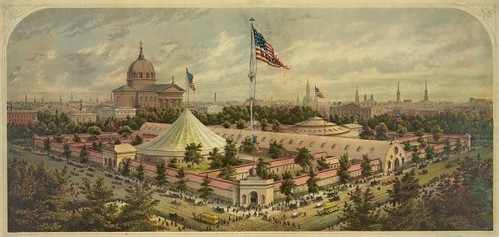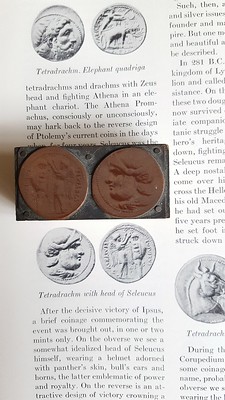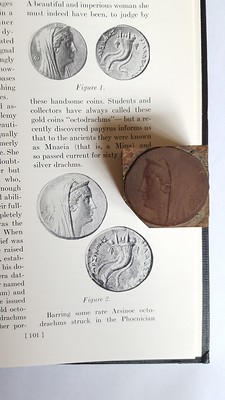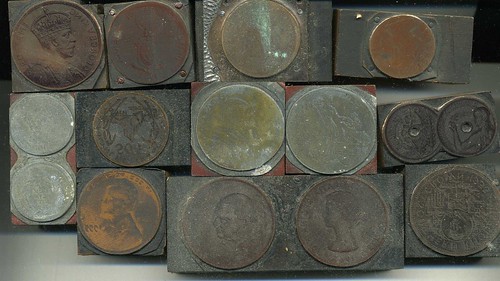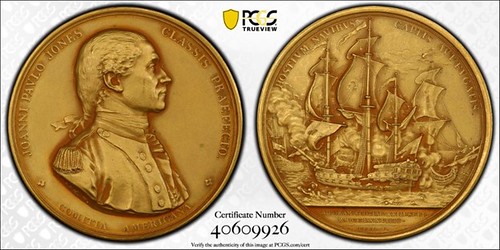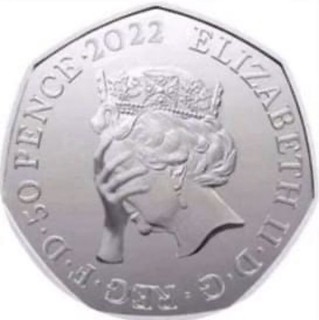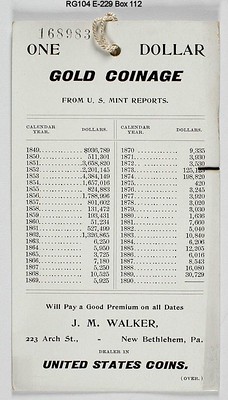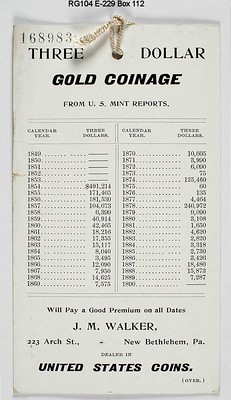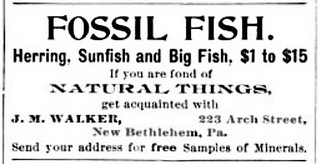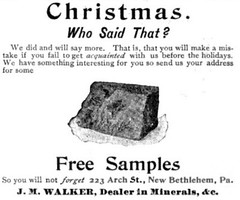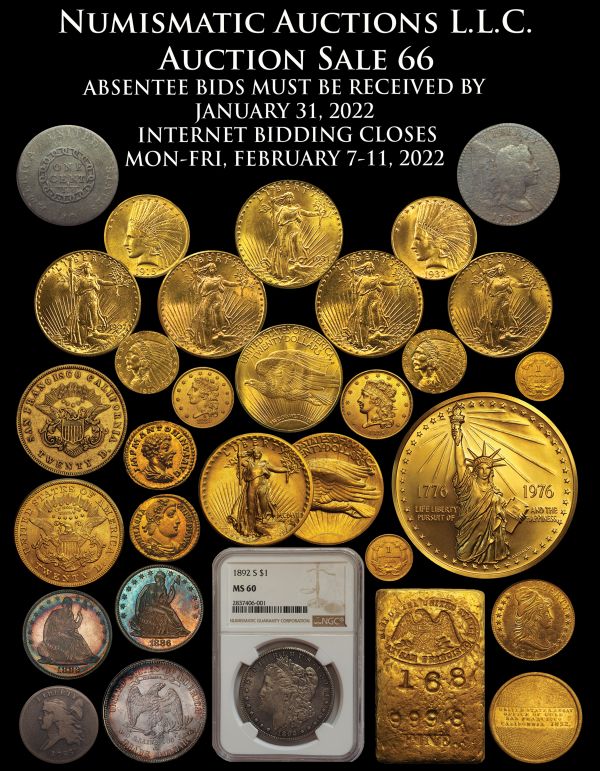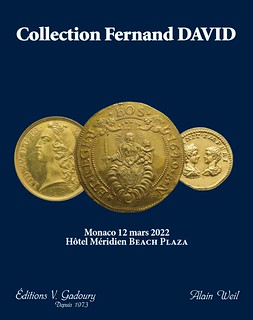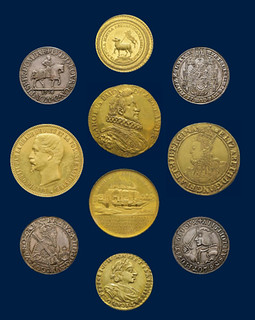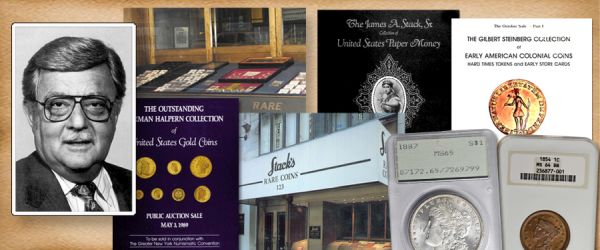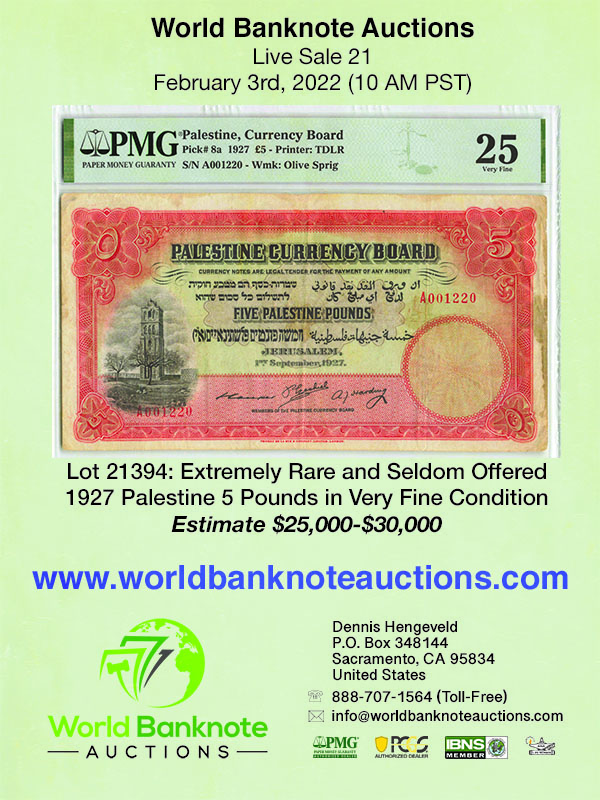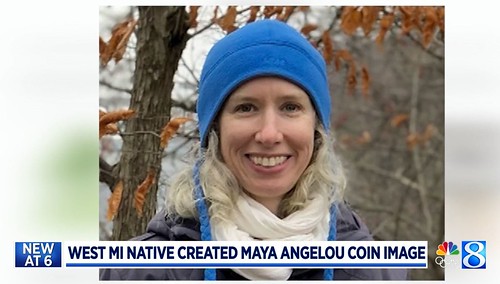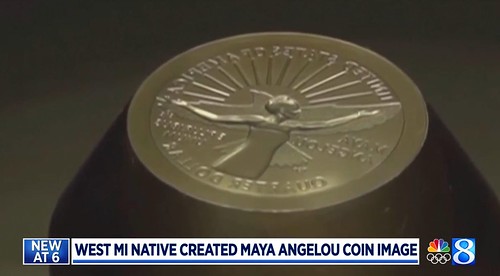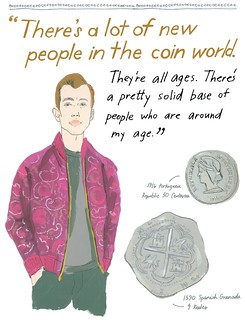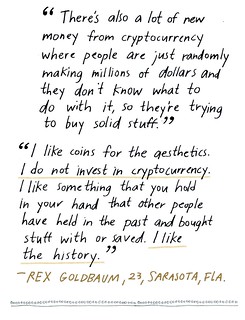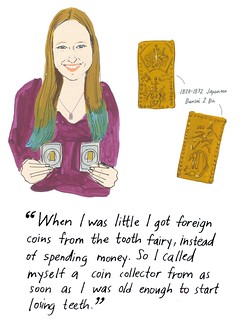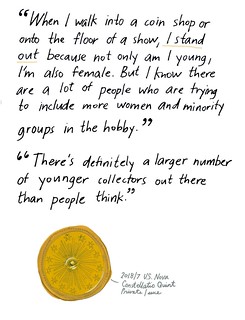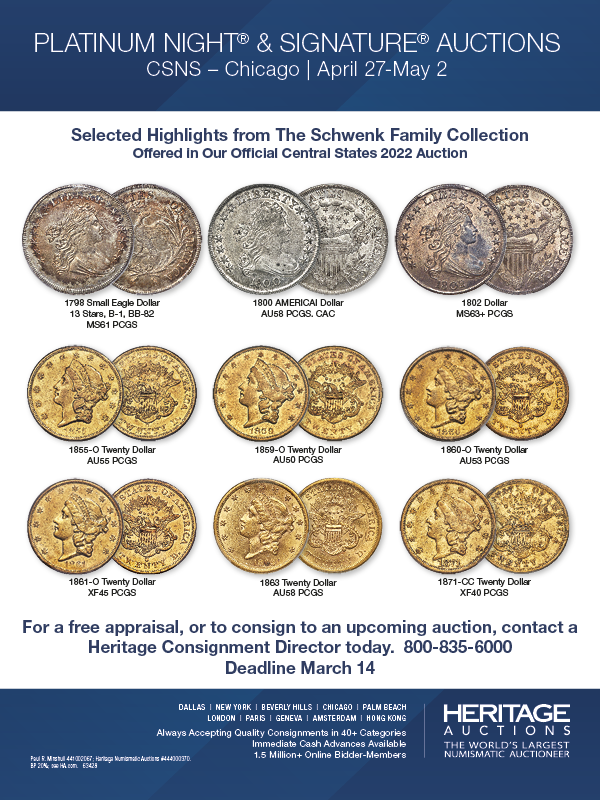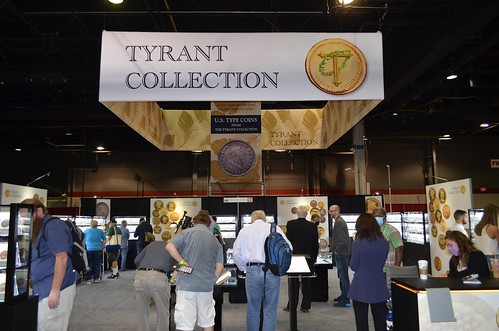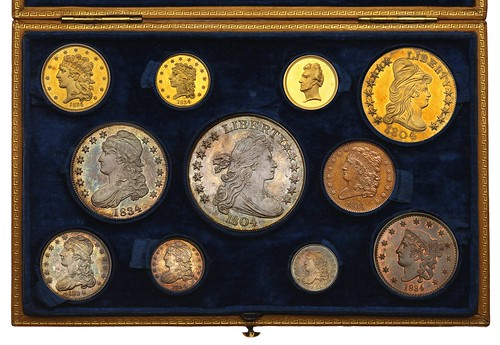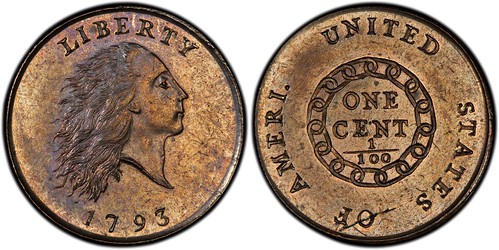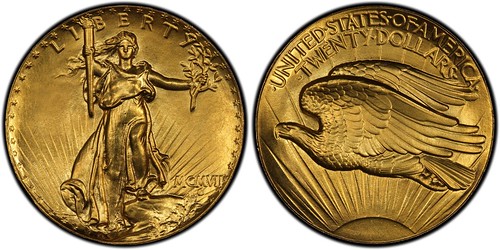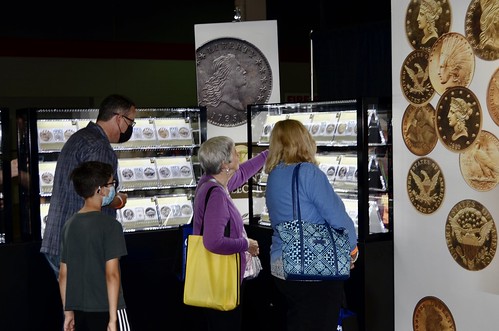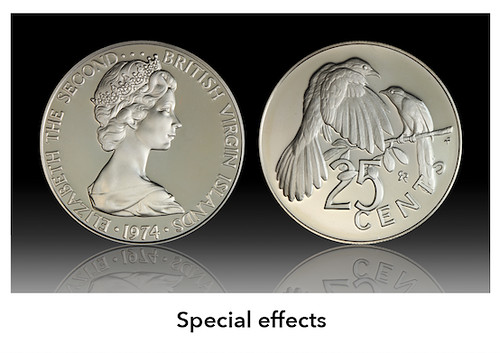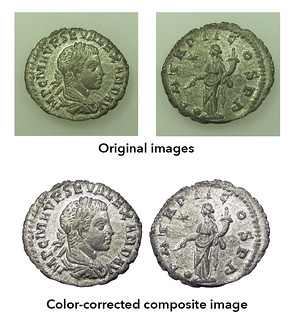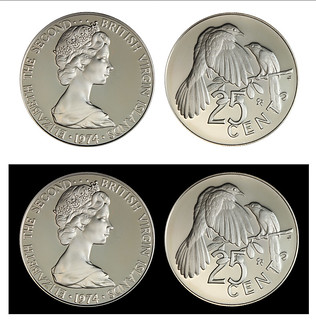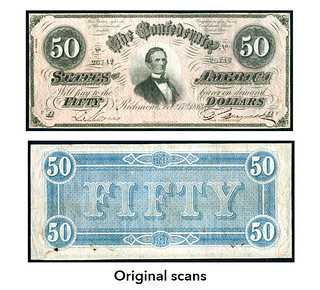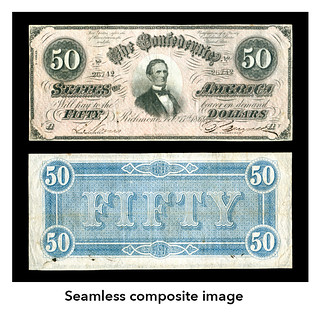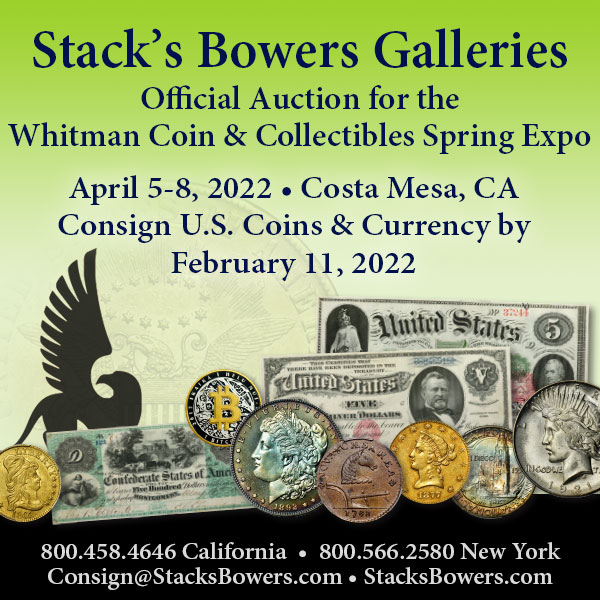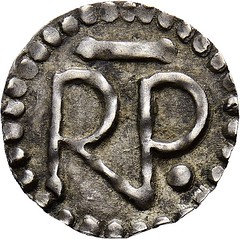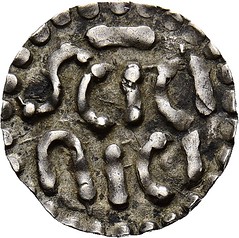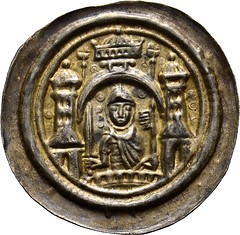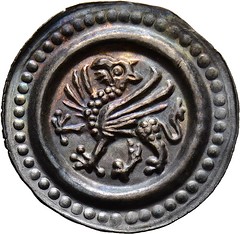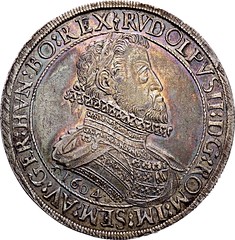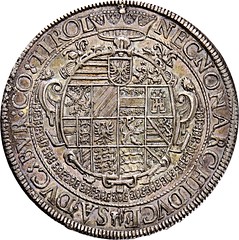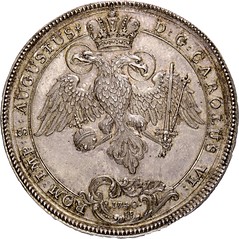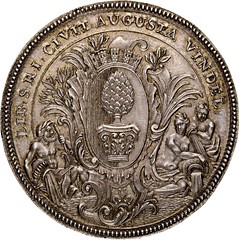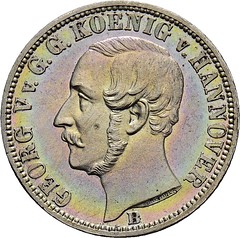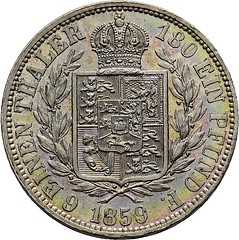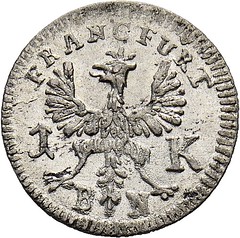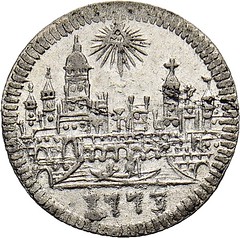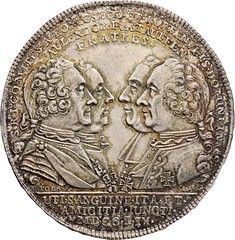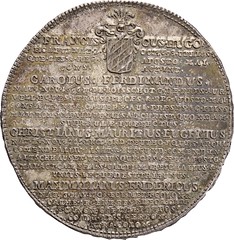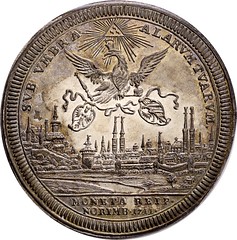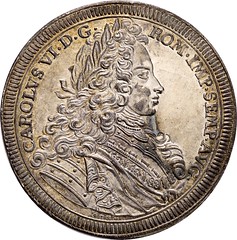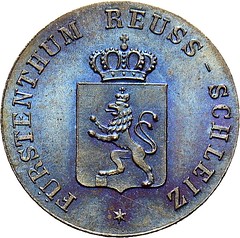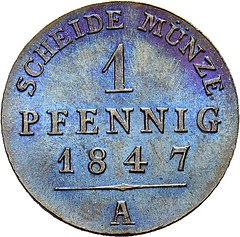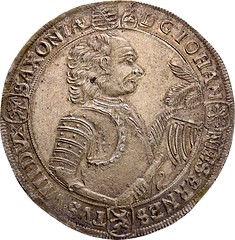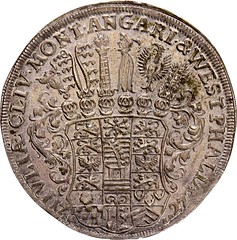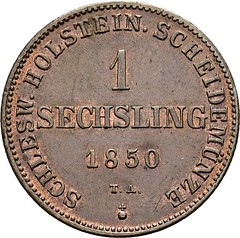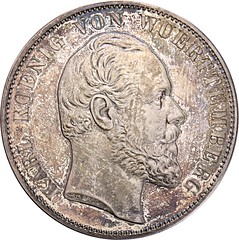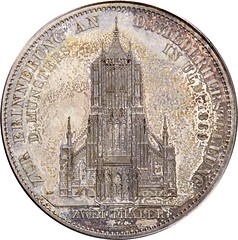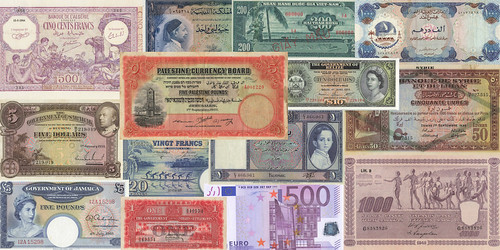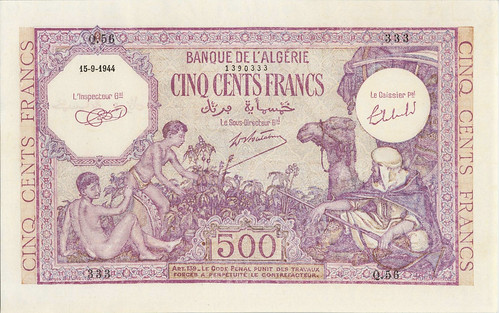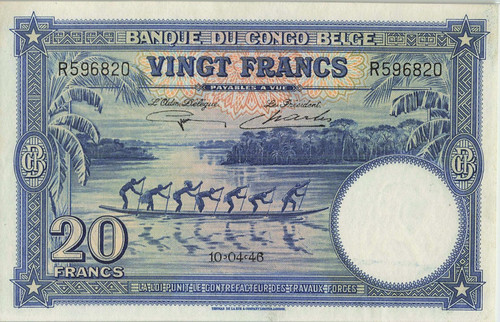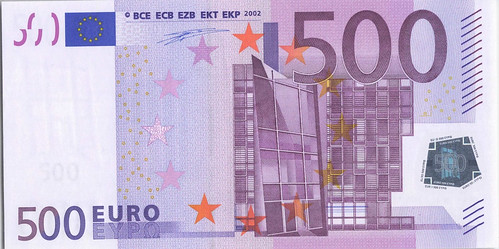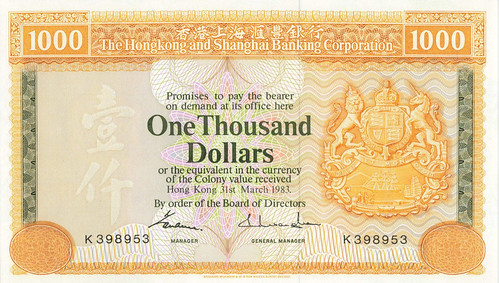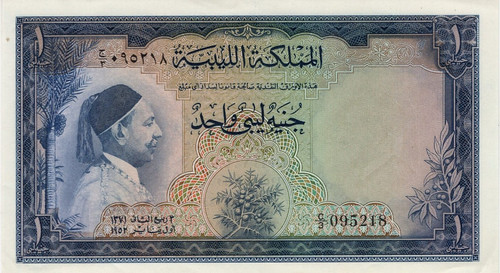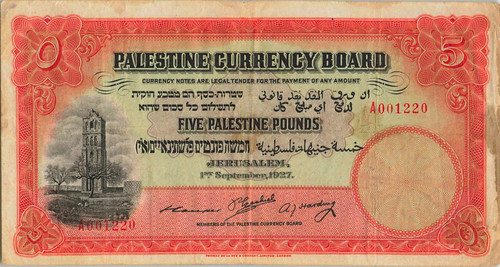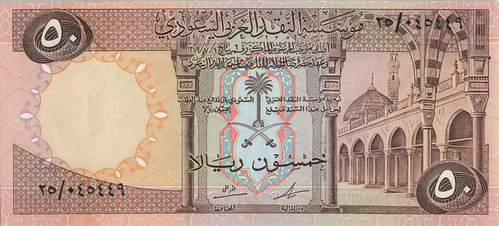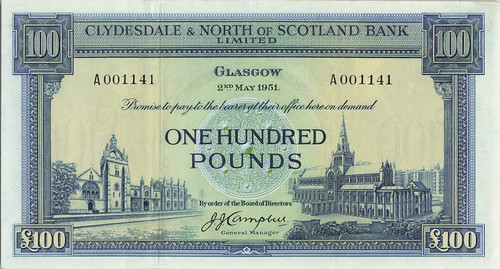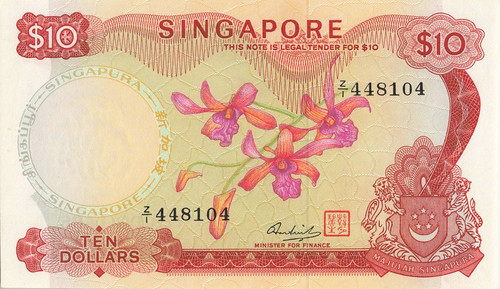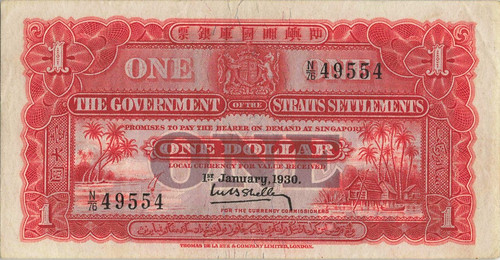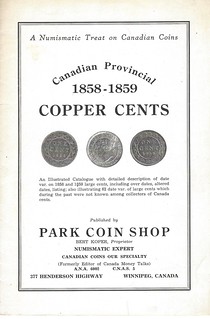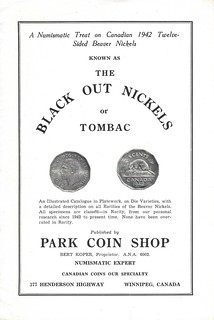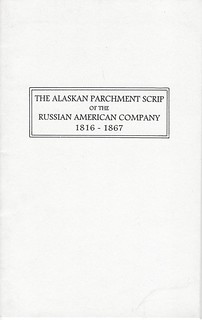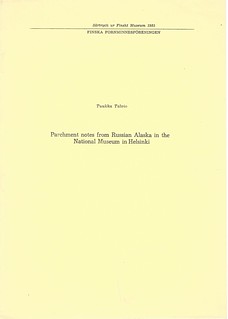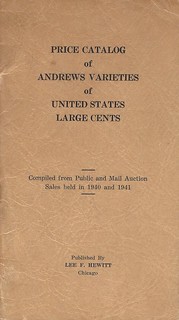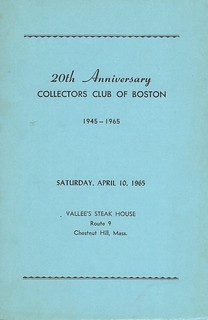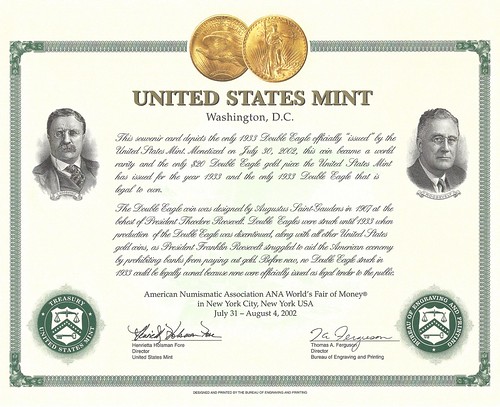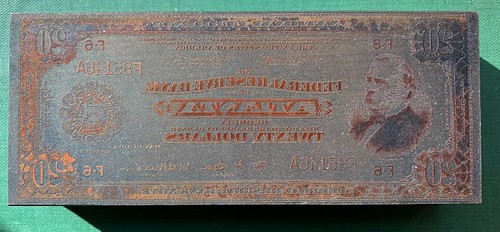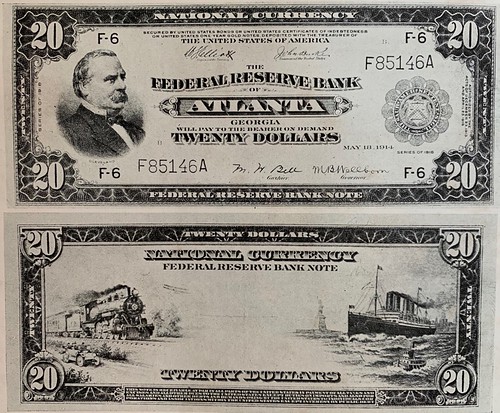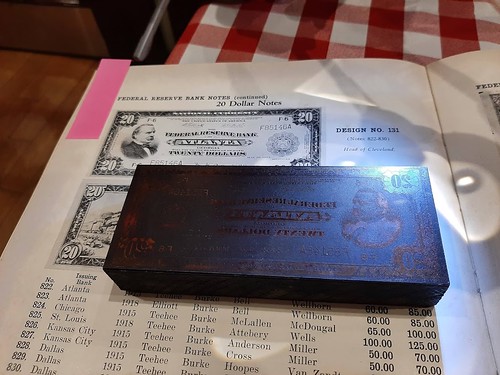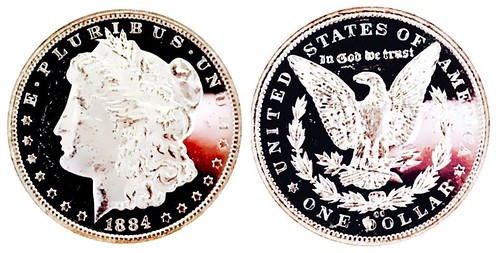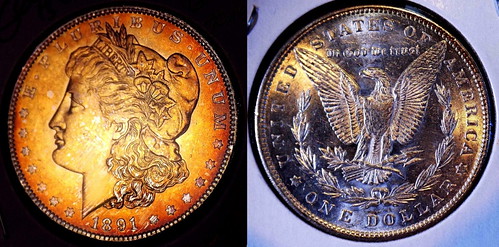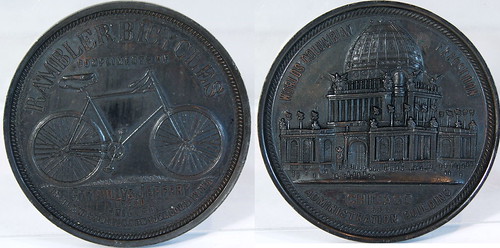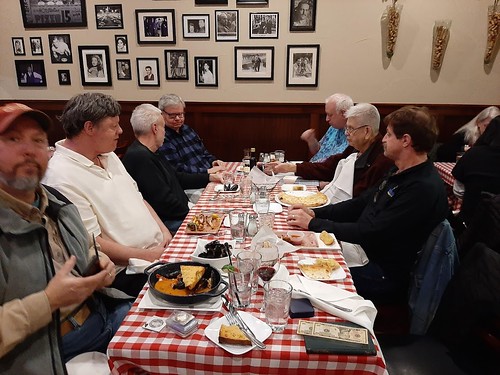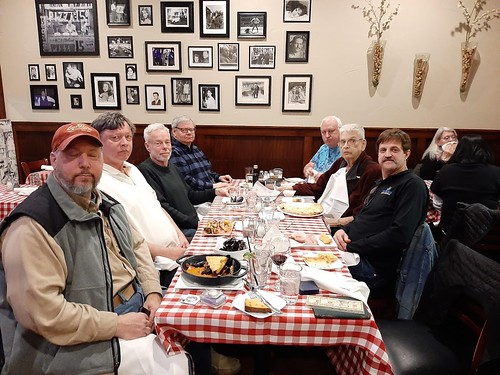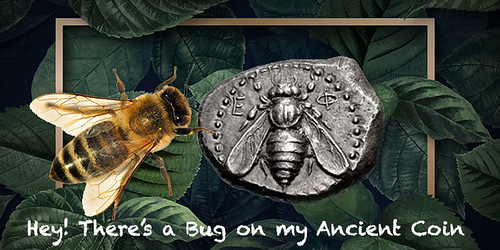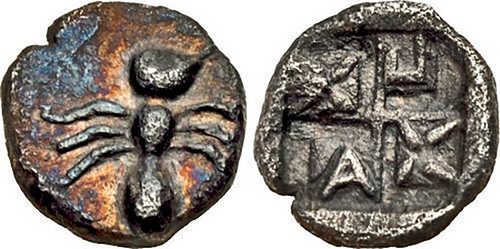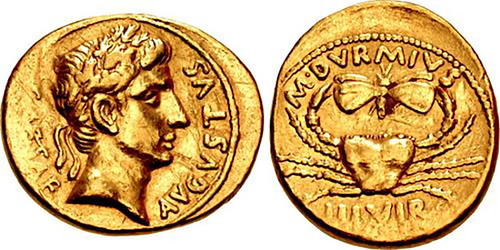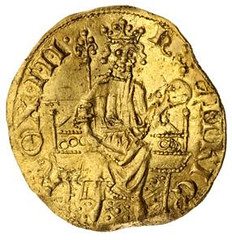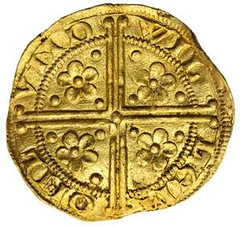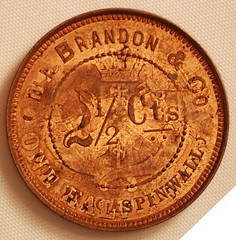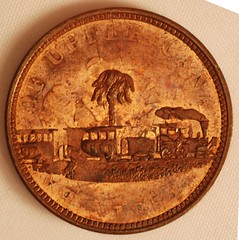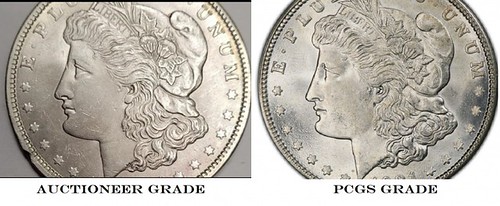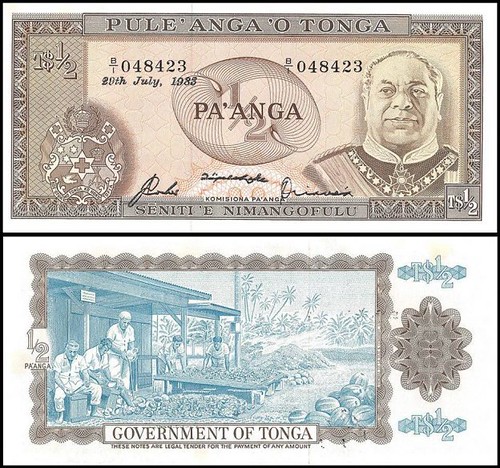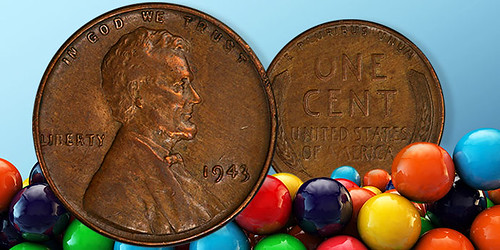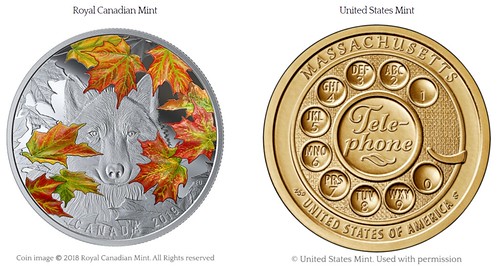
Visit our NBS Sponsors


About UsThe Numismatic Bibliomania Society is a non-profit association devoted to the study and enjoyment of numismatic literature. For more information please see our web site at coinbooks.org SubscriptionsThose wishing to become new E-Sylum subscribers (or wishing to Unsubscribe) can go to the following web page link MembershipThere is a membership application available on the web site Membership Application To join, print the application and return it with your check to the address printed on the application. Print/Digital membership is $40 to addresses in the U.S., and $60 elsewhere. A digital-only membership is available for $25. For those without web access, write to: Charles Heck, Treasurer AsylumFor Asylum mailing address changes and other membership questions, contact Chuck at this email address: treasurer@coinbooks.org SubmissionsTo submit items for publication in The E-Sylum, write to the Editor at this address: whomren@gmail.com BUY THE BOOK BEFORE THE COINSale CalendarWatch here for updates! |
- WAYNE'S WORDS: THE E-SYLUM JANUARY 23, 2022
- SOLIDUS LITERATURE AUCTION 93
- NEW BOOK: GUIDE BOOK OF QUARTER EAGLE GOLD
- NEW BOOK: SPANISH CUARTILLOS
- NEW BOOK: COINS OF CANADA 40TH EDITION
- NEW BOOK: ERRORS ON CANADIAN COINS, VOLUME 2
- HENDIN AND WACKS SHARE 2022 SHEKEL PRIZE
- STRONG STATE OF THE NUMISMATIC BOOK MARKET
- NNP ADDS EARLY AMERICAN NUMISMATICS
- THE 1861-O
CONFEDERATE
HALF DOLLARS - VIDEO: DR. DAVID CLOSE
- CASTLECOMER COLLIERY COUNTERMARKS
- WEGEFARTH'S GOLD AND SILVER DOLLAR SALOONS
- ELIASBERG 1850 BALDWIN & CO. $5 REDISCOVERED
- NOTES FROM E-SYLUM READERS: JANUARY 23, 2022
- WHO WAS J. M. WALKER?
- NEW REPORT EXAMINES U.S. MINT RACIAL TENSIONS
- VOCABULARY TERM: HEADER, HEADER BAR
- FERNAND DAVID (1861-1927)
- HARVEY STACK'S NUMISMATIC FAMILY, PART 113
- NYT: HARVEY G. STACK DIES AT 93
- DAMSTRA ON DESIGNING MAYA ANGELOU QUARTER
- LIPSON HEADS OTTAWA NUMISMATIC SOCIETY
- NYT FEATURES MILLENNIAL AND GEN Z COLLECTORS
- FRANK ROBINSON AT THE NEW YORK INTERNATIONAL
- LONG BEACH TYRANT COLLECTION U.S. TYPE EXHIBIT
- ANA COURSE: NUMISMATIC DIGITAL IMAGE EDITING
- KÜNKER SALE 360: COLLECTION OF A CONNOISSEUR
- WORLD BANKNOTE AUCTIONS SALE 21
- WAYNE'S NUMISMATIC DIARY: JANUARY 23, 2022
- BUGS ON ANCIENT COINS
- FINDING THE HENRY III GOLD PENNY
- QUERY: MYSTERY ASPINWALL TOKEN
- LOOSE CHANGE: JANUARY 23, 2022
- FEATURED WEB SITE: EMILY S. DAMSTRA
Click here to read the thin version on the web
Click here to subscribe
Click here to access the complete archive
To comment or submit articles, reply to whomren@gmail.com
Content presented in The E-Sylum is not necessarily researched or independently fact-checked, and views expressed do not necessarily represent those of the Numismatic Bibliomania Society.
WAYNE'S WORDS: THE E-SYLUM JANUARY 23, 2022
 New subscribers this week include:
Ken Shupe, courtesy Steve Shupe; and
Sandy Gatchell, courtesy Martin Kaplan;
Welcome aboard! We now have 6,740 subscribers.
New subscribers this week include:
Ken Shupe, courtesy Steve Shupe; and
Sandy Gatchell, courtesy Martin Kaplan;
Welcome aboard! We now have 6,740 subscribers.
Thank you for reading The E-Sylum. If you enjoy it, please send me the email addresses of friends you think may enjoy it as well and I'll send them a subscription. Contact me at whomren@gmail.com anytime regarding your subscription, or questions, comments or suggestions about our content.
This week we open with one numismatic literature sale, four new books, the Shekel book prize, updates from the Newman Numismatic Portal, notes from E-Sylum readers, and more.
Other topics this week include the 1861 New Orleans "Confederate" half dollars, an 1850 Baldwin & Co. $5 gold piece, racial tensions at the U.S. Mint, collector Fernand David, coin designer Emily Damstra, the New York International, the Tyrant Collection, auction previews, and imagining a Home Depot but filled with coins.
To learn more about Quarter Eagle Gold coins, Spanish Cuartillos, errors on Canadian coins, the state of the numismatic book market, the Gold and Silver Dollar Saloons, U.S. Sanitary Fair numismatic offerings, J. M. Walker's Gold Buying Guide, Jacob Lipson, Lianna Spurrier, Pepin the Short, Albert the Bear, the King of Siam proof set, and bugs on ancient coins, read on. Have a great week, everyone!
Wayne Homren
Editor, The E-Sylum
SOLIDUS LITERATURE AUCTION 93
The Solidus firm in Munich is devoting their 93rd auction sale to numismatic literature. Here's the announcement. -Editor
Literature auction 93 on Sunday, February 6th, 2022 at 5 p.m. CET: Selected literature on numismatics from the Middle Ages and Modern times
With almost 600 lots, our literature auction offers an excellent opportunity to supplement your own numismatic library:
To our literature auction on Auex
To our literature auction on Numisbids
Here you can download a pdf with all books (without pictures)
All auctions take place as live auctions on Auex. Bids can always be submitted in advance.
To visit the Solidus website, see:
http://www.solidus-numismatik.de/
NEW BOOK: GUIDE BOOK OF QUARTER EAGLE GOLD
Whitman has published Dave Bowers's new book on Quarter Eagle Gold coins. -Editor
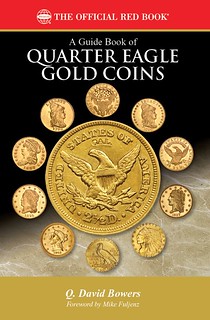 Whitman Publishing announces the upcoming release of A Guide Book of Quarter Eagle Gold Coins, by Q. David Bowers. The new 448-page book is volume 26 in Whitman's
Whitman Publishing announces the upcoming release of A Guide Book of Quarter Eagle Gold Coins, by Q. David Bowers. The new 448-page book is volume 26 in Whitman's Bowers Series
of numismatic references. It will debut in March 2022, available from booksellers and hobby shops nationwide, for $29.95. In the meantime, it is available for preorder (including at www.Whitman.com and online bookstores).
The quarter eagle, face value of $2.50, occupies an unusual place in American currency,
Bowers says. Unlike larger gold coins, it was too small to be commonly used in export and international trade. It also never became popular in day-to-day commerce (though, like the smaller gold dollar, it was frequently given as a Christmas gift). Despite this,
Bowers says, the quarter eagle was minted almost continuously for more than 130 years, starting in 1796, with six different design styles over the years.
Today the quarter eagle is a favorite among collectors who see it as a denomination challenging to collect, yet accessible. Rarities like the 1841 Little Princess
and the 1848 CAL. type (struck to commemorate the discovery of gold in California) always bring excitement when they cross the auction block.
In the Guide Book of Quarter Eagle Gold Coins, Bowers—the hobby's leading numismatic researcher and author—applies his signature expertise to the denomination. With characteristic thoroughness he delves into its economic and historical context, from bank panics and bullion legislation to gold rushes and Civil War hoarding. He gives readers an encyclopedic study of every quarter eagle ever minted, with full-color images, values by grade, mintages, rarity ratings, die data, auction records, collecting advice, and more. Each of the design styles—and their die varieties—is discussed in detail.
This latest Bowers Series volume will make you an expert on the quarter eagle,
said Whitman publisher Dennis Tucker. Every collector, investor, and student of American money will learn valuable lessons from it.
Gold dealer Mike Fuljenz calls it An important book that takes the reader on a fascinating journey through history, using the quarter eagle as a ‘time machine.'
The Guide Book of Quarter Eagle Gold Coins is richly illustrated. Of particular note are the coin photographs in chapter 3, showing varieties of 1796–1834 quarter eagles, which were provided by the Harry W. Bass, Jr. Foundation. Mark Borckardt, Senior Numismatist of Heritage Auctions, coauthored chapter 10, on the Classic Head quarter eagles of the 1830s.
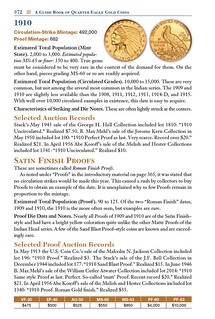 Topics covered include mints and minting; circulation and distribution; Proofs minted for collectors; quarter eagles on the numismatic scene; and understanding the market. Bowers catalogs the Capped Bust and Draped Bust types (1796–1808); the Capped Head type (1821–1834); the Classic Head type (1834–1839); the Liberty Head type (1840–1907); and the Indian Head type (1908–1929).
Topics covered include mints and minting; circulation and distribution; Proofs minted for collectors; quarter eagles on the numismatic scene; and understanding the market. Bowers catalogs the Capped Bust and Draped Bust types (1796–1808); the Capped Head type (1821–1834); the Classic Head type (1834–1839); the Liberty Head type (1840–1907); and the Indian Head type (1908–1929).
Appendices give more information on pattern $2.50 gold coins; quarter eagles found in treasures and hoards; historical news coverage of the quarter eagle; error coins; and counterfeits.
A detailed index and a selected bibliography assist the reader in in-depth research.
The Guide Book of Quarter Eagle Gold Coins is the 20th volume written by Q. David Bowers in Whitman's 26-volume Bowers Series.
Other authors in the series include David W. Lange, Richard Snow, Katherine Jaeger, Roger W. Burdette, Frank J. Colletti, and Rick Tomaska.
A Guide Book of Quarter Eagle Gold Coins, first edition.
By Q. David Bowers; foreword by Mike Fuljenz.
ISBN 0794847331. Softcover, 6 x 9 inches, 448 pages, full color.
Retail $29.95 U.S.
https://whitman.com/a-guide-book-of-quarter-eagle-gold-coins/
NEW BOOK: SPANISH CUARTILLOS
Author Emilio Ortiz submitted this announcement of his new books on the Spanish Cuartillos. Thanks. -Editor
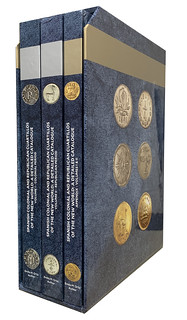 I am pleased to announce that the Cuartillo catalogues
I am pleased to announce that the Cuartillo catalogues SPANISH COLONIAL &
REPUBLICAN CUARTILLOS OF THE NEW WORLD: A DETAILED CATALOGUE
, have
been printed and are ready to be mailed.
These catalogues represent an in-depth research of the totality of Cuartillos struck from 1505 to 1909 by every Colonial and Republican Mint with enlarged images of each coin. The set consists of Volume I covering the Spanish Colonial Period, Volume II covering the Republican Period and an Appendix for Volumes I & II.
Each set is hardbound and numbered. Orders are being accepted for immediate shipment at a price of US $640 or Euros 600 per set which includes shipping. For payment instructions please contact the author at cuartosdereal@gmail.com.
NEW BOOK: COINS OF CANADA 40TH EDITION
The new edition of Coins of Canada is now available. -Editor
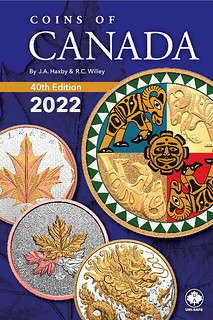 The 40th edition of The Coins of Canada is a complete, one-volume library of Canadian coins, tokens and paper money, including major varieties. Available in English and French.
The 40th edition of The Coins of Canada is a complete, one-volume library of Canadian coins, tokens and paper money, including major varieties. Available in English and French.
Features:
- Complete Canadian decimal coinage
- Pre-Confederation Provincial issues
- All Canadian Mint silver and gold collector's issues
- Canadian colonial tokens
- Dominion of Canada banknotes 1867-1935
- Bank of Canada paper money 1935 to date
- Latest retail market values by grade
- Detailed mintage figures and statistics
- Much historical background and pertinent information
- Condition Grading Guides for Canadian coins
- Includes a glossary of numismatic terms
2022 Coins of Canada – 40th Edition
BY J.A. HAXBY & R.C. WILLEY
ISBN 10: 1-894763-77-6
ISBN 13: 978-1-894763-77-6
Weight: 1.25 kg
Dimensions: 23 × 18.5 × 4 cm
$31.95
For more information, or to order, see:
2022 Coins of Canada – 40th Edition
(https://coinstampsupplies.com/product/2022-coins-of-canada-40th-edition/)
NEW BOOK: ERRORS ON CANADIAN COINS, VOLUME 2
Howard Engel of Richard Stockley Books forwarded this announcement of the new volume of Christian Houle's books on Canadian coin errors and varieties. Thank you. -Editor
Stockley Books offers latest publications on Canadian QEII 1-cent & 5-cent varieties by Christian Houle of Quebec
Howard R. Engel, Proprietor of Richard Stockley Books (RSB) of Winnipeg, Manitoba, Canada offers the latest publications on errors and varieties of both Queen Elizabeth the Second 1-cent and 5-cent Canadian coins all signed by the author, Christian Houle of Quebec. Spiral bound (lays flat) with bilingual text (in English and French) replete with many full-colour close-up images and organized chronologically with the author's own numbering system, they are a must have for any serious collector of the following Queen Elizabeth II issues: 1-cent pieces from 1953 to 2012 when this series was discontinued by the Royal Canadian Mint (published in 2018) and 5-cent pieces from 1953 to 1981 (published in 2021).
Volume 1 covers such 1-cent varieties like the 1953-55 with or no shoulder strap, with or no serif letters, the 1965 and 1985 blunt or pointed 5, the 1999 with or no P mint mark and the 2003 with P or logo mark. Errors like brockage, die cap, chip & clash, clipped planchet, die crack, damaged die, design doubling, deteriorated die, dot, indented planchet, delamination , mated pair, off-centre strike, clockwise & counter-clockwise rotation, split planchet, struck through grease/oil, and weak strike are well-defined and illustrated in both volumes, in addition to errors found on only one denomination or the other.
Volume 2 covers the main 5-cent varieties of the 1953 near or far maple leaves, the 1953-54 no shoulder fold, shoulder fold, the 1965 small or large beads and the 1977 high or low 7, plus many minor ones like the 1957-59, 1964-65, 1972 and 1974 bugtail, the 1964 extra water line, and the many years of extra wood, missing wood, extra claw(s), missing claw(s), bald head, extra and missing water lines, etc.
For those who enjoy varieties numismatics publications themselves the first printing of vol. 1 on the 1-cent pieces has the author's old address on the title page, while the 2nd printing has the author's current address. The first printing of vol. 2 on the 5-cent pieces has a non-smiling portrait of the author in a blue shirt while the second printing of vol. 2 has a smiling portrait of the author in a red shirt. Pricing is as follows: $70 each plus shipping and handling for the 1st printing and $65 each for the 2nd printing or $130 for the 1st printing pair and $120 for the 2nd printing pair, plus shipping and handling. Prices are in CAD for customers domiciled in Canada shipped to a Canadian address and in USD for all other customers outside Canada.
Besides these latest books of Canadian errors and varieties RSB also has many other publications of yore relating to errors and varieties in both Canadian (e.g. by Bert Koper, Hans Zoell, et al.) and U.S. decimal coins (e.g. Mort Goodman's Design Cud, Modern Mint Mistakes by Steiner & Zimpfer, Flynn's Guide to Misplaced Dates & Arnold Margolis' Error Coin Encyclopedia). Fixed price lists are available upon request by dropping a line to richardstockleybooks@mymts.net.
To read the earlier E-Sylum articles, see:
NEW BOOK: ERRORS AND VARIETIES ON CANADIAN COINS
(https://www.coinbooks.org/v21/esylum_v21n43a02.html)
BOOK REVIEW: ERRORS AND VARIETIES ON CANADIAN COINS
(https://www.coinbooks.org/v21/esylum_v21n48a04.html)
HENDIN AND WACKS SHARE 2022 SHEKEL PRIZE
The 2022 Shekel Prize competition was a dead heat this year between two excellent new books. Here's the announcement. -Editor
The 2022 Shekel Prize, for the best book on the subject of Ancient Judaean, Holy Land, Israel, or Jewish Numismatics, is being shared by two books: Guide to Biblical Coins, 6th Edition
by David Hendin and The Handbook of Biblical Numismatics, 45th Anniversary Edition
by Mel Wacks. Dr. Ira Rezak, Acting Chair of the Shekel Prize Committee, announced that the decision was unanimous, after Hendin and Wacks recused themselves.
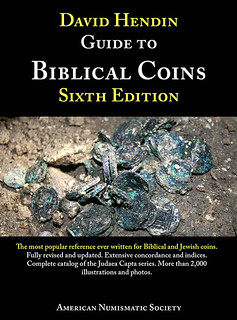 Hendin has revised and updated his
Hendin has revised and updated his Guide to Biblical Coins,
which is the standard reference in the field, to reflect relevant discoveries in archaeology and numismatics of ancient Israel. The metallurgy of Judean coins, symbols on Hasmonean cons, the Hasmonean coin chronology, Herodian mints, irregular issues, the Jewish War, and coin denominations are only a few of the topics that Hendin has updated. New to the sixth edition is numismatic information about the Kingdom of Adiabene, the Ituraean Kingdom, the Roman Governors of Syria, and coins with images of Old Testament stories. Many hundreds of new and improved graphics help illuminate the text. The photo plates have been expanded dramatically as have the images in the catalog and text. Includes a complete concordance between previous editions of GBC as well as other key references, elaborate end notes, an expanded bibliography, a full index, and an index of Latin inscriptions on the Judaea Capta coins.
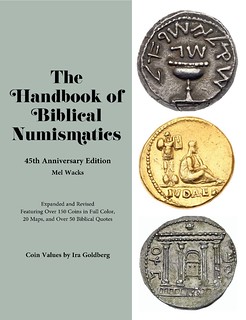 Wacks'
Wacks' Handbook of Biblical Numismatics, 45th Anniversary Edition
features over 150 coins in full color, 20 maps, over 50 Biblical quotes. and estimated coin values by Ira Goldberg. While the book is still easily read by the novice, it also contains the latest theories of experts in the field on controversial subjects like the bud (pomegranate or poppy?) appearing in between double cornucopia on Hasmonean coins, the vessel (chalice or pot of manna?) and budding plant (pomegranates or Aaron's rod?) on First Revolt Shekels, etc. The coins mentioned in the New Testament also receive attention - the Widow's Mite, Tribute Penny and Thirty Pieces of Silver. Readers will also learn about the Herodian Kings of Armenia, the Jewish Princess Salome, and the connection between Cleopatra and Judaea. Appendices include Ancient Hebrew Coin Inscriptions, The Holy of Holies on Ancient Judaean Coins, Roman Tenth Legion Counterstamps, and False Shekels.
David Hendin is First Vice President of the American Numismatic Society; Mel Wacks and Dr. Ira Rezak are Life Fellows of the ANS.
Both books are available on Amazon, and Wacks' book can be read on the Newman Numismatic Portal.
The Shekel Prize was established by the American Israel Numismatic Association in 2017; information about past winners can be found at www.theshekel.org.
To read earlier E-Sylum articles, see:
NEW BOOK: HANDBOOK OF BIBLICAL NUMISMATICS
(https://www.coinbooks.org/v24/esylum_v24n31a04.html)
BOOK PREVIEW: GUIDE TO BIBLICAL COINS 6TH ED.
(https://www.coinbooks.org/v24/esylum_v24n47a04.html)
STRONG STATE OF THE NUMISMATIC BOOK MARKET
In this Coin Update article, Dennis Tucker of Whitman Publishing discusses the strong state of the numismatic book market in 2021. -Editor
The Handbook of United States Coins, popularly known as the Blue Book,
celebrates 80 years of publication in 2022. It gives wholesale prices for U.S. coins—how much dealers are paying for individual coins, on average.
Book sales in the United States were very strong in 2021, according to data from NPD BookScan, which reports on about 85 percent of print sales nationwide (through all major retailers including Amazon, Barnes & Noble, Books-A-Million, Target, Walmart, and independent bookstores).
This follows an upward trend we've seen over the course of the COVID pandemic. In rounded numbers: In 2019, reported unit sales nationwide were 694 million books; in 2020, 758 million; and in 2021, 826 million.
COVID has created a strange environment for data benchmarking, though. You really have to study the numbers, and what's behind them, to come to insightful conclusions (and avoid misinterpretations).
For example, within the category of adult nonfiction, the subcategory of travel books saw the most dramatic increase this past year, up 23 percent. That's not surprising, since everyone was sheltering in place in 2020. The travel-book niche crashed that year. Finally, in 2021 we were able to travel more comfortably and securely, and reader demand for travel books took off again.
(My own 2021 travels consisted of two trips: One to New York to visit family in June/July, and the second in August, to Chicago, for the American Numismatic Association World's Fair of Money. A far cry from the old normal
of a half-dozen or more trips per year—but it felt like a lot more than the zero trips of 2020!)
After travel, the second-largest 2021 gain within adult nonfiction was in business and economic books, which enjoyed increased sales of 19 percent. Are Americans starting more DBAs and pursuing new entrepreneurial opportunities?
One thing is certain: Book sales are strong, and that includes antiques and collectibles. Across all adult nonfiction (the category that includes nearly every numismatic book), the year's sales were up 4.4 percent over 2020.
The Blue Book's famous companion, the Red Book, contains more historical information and technical details, and gives retail prices for U.S. coins (how much a collector can expect to pay for them). Demand for the Red Book increased in 2021.
Demand for the annual Guide Book of United States Coins (the Red Book
) is a bellwether of the strength of the rare-coin market. (Case study: The boom market of the early 1960s; in 1964 the 18th edition sold a record-setting 1,200,000 copies.) Everywhere you look, coin dealers and auction firms are reporting 2021 as a very successful year, and we see that reflected in the publishing world. Collector demand for the Red Book increased in 2021, even after we saw stronger and stronger demand in 2019 and 2020. Whitman Publishing kept the presses running to ensure supplies of the 75th edition met collector interest.
The new year will bring a crop of new books for coin and paper-money collectors, including an expanded and updated Cherrypickers' Guide to Rare Die Varieties of United States Coins.
2022, meanwhile, is shaping up as an exciting year, with new Whitman books on their way. World coins will be well represented, in addition to U.S. coins. The silver bullion market will see two new publications. Several Bowers Series books will be updated in new editions, including Barber coins and Morgan silver dollars. Die-variety collectors will welcome the latest volume of the Cherrypickers' Guide. And of course, the perennial Red Book, Blue Book, and Mega Red will be on bookshelves before you know it.
Reading and coin collecting go hand in hand. It appears the new year will bring more of both as the boom continues.
To read the complete article, see:
Notes Published: The 2022 State of the Rare Coin Market, on the books
(http://news.coinupdate.com/notes-published-the-2022-state-of-the-rare-coin-market-on-the-books/)
NNP ADDS EARLY AMERICAN NUMISMATICS
The latest additions to the Newman Numismatic Portal are early issues of the Journal of Early American Numismatics. Project Coordinator Len Augsburger provided the following report. -Editor
American Numismatic Society Opens Journal of Early American Numismatics
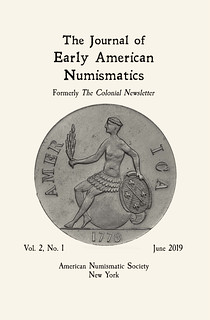 The American Numismatic Society has made available the first four semi-annual issues of the Journal of Early American Numismatics (JEAN), covering the years 2018-2019. Editor Chris McDowell notes that ANS intends to open additional issues in the future, maintaining a three-year lag with the print publication. The Journal is the successor publication to The Colonial Newsletter (1960-2017). Topics covered in the 2018 and 2019 issues include a wide variety of colonial issues including Connecticut and Fugio cents, Rhode Island ship medals, Spanish colonial coinage, and the ever provocative Continental dollar. Thanks to ANS Director of Publications Andrew Reinhard and JEAN Editor Chris McDowell for their assistance with this title.
The American Numismatic Society has made available the first four semi-annual issues of the Journal of Early American Numismatics (JEAN), covering the years 2018-2019. Editor Chris McDowell notes that ANS intends to open additional issues in the future, maintaining a three-year lag with the print publication. The Journal is the successor publication to The Colonial Newsletter (1960-2017). Topics covered in the 2018 and 2019 issues include a wide variety of colonial issues including Connecticut and Fugio cents, Rhode Island ship medals, Spanish colonial coinage, and the ever provocative Continental dollar. Thanks to ANS Director of Publications Andrew Reinhard and JEAN Editor Chris McDowell for their assistance with this title.
Link to Journal of Early American Numismatics on Newman Portal:
https://nnp.wustl.edu/library/publisherdetail/544833
THE 1861-O CONFEDERATE
HALF DOLLARS
Newman Numismatic Portal Project Coordinator Len Augsburger provided an additional report on NNP resources concerning the 1861-O Confederate
Half Dollars.
-Editor
The 1861-O half dollar is an exceptionally popular issue, with pieces variously struck under Union, Louisiana, and Confederate authority. The recovery of thousands of examples from the SS Republic shipwreck, discovered in 2003, only adds to the lore of the popular issue. Randy Wiley detailed the 1861-O half dollar varieties in the November 2005 and November 2006 editions of the Gobrecht Journal, and these two issues are likely the most referenced in the entire series. Wiley's first article outlined the emission sequence and the 15 die marriages for this issue and presented a step-by-step attribution guide.
Wiley's second article takes the leap from variety attribution toward the discovery of the coining authority for each variety. The 1887 Mint Director's report indicated the number of pieces struck under each coining authority, and Wiley also had access to SS Republic data, which he analyzed to determine the overall distribution of the 1861-O issue by variety. Wiley notes that his final analysis is somewhat speculative, but in the end he identified two die marriages for the Union issues, seven for the Louisiana issues, and six for the CSA-struck pieces.
Bill Bugert picked up the thread in 2013 in his A Register of Liberty Seated Half Dollar Varieties, Volume IV, New Orleans Branch Mint 1853-O WA to 1861-O. This source adds easy-to-use photographs for each die pair, with high quality images depicting the various pickup points for each variety.
Images: 1861-O 50c, NGC XF40, W-11, featuring the CSA die crack at Liberty's nose. Ex. Newman IX (Heritage Auctions, November 2017), lot 15121, realized $2,880.
Link to the Gobrecht Journal on Newman Portal:
https://nnp.wustl.edu/library/publisherdetail/2096
Link to A Register of Liberty Seated Half Dollar Varieties, Volume IV, New Orleans Branch Mint 1853-O WA to 1861-O on Newman Portal:
https://nnp.wustl.edu/library/book/529689
VIDEO: DR. DAVID CLOSE
These are selections from the David Lisot Video Library that feature news and personalities from the world of coin collecting. David has been attending coin conventions since 1972 and began videotaping in 1985. The Newman Numismatic Portal now lists all David's videos on their website at:
https://nnp.wustl.edu/library/multimediadetail/522852
Here's an interview with variety collector Dr. David Close. -Editor
Medical Doctor Coin Collector Gives COVID Advice.
VIDEO: 3:17.
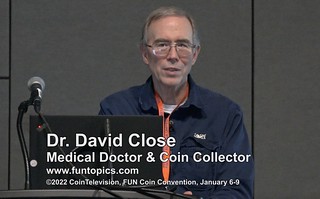 Dr. David Close, Medical Doctor and Coin Collector, David Lisot, Interviewer, CoinTelevision.com. January 6-9, 2022.
Dr. David Close, Medical Doctor and Coin Collector, David Lisot, Interviewer, CoinTelevision.com. January 6-9, 2022.
Dr. David Close is a general medical practitioner. He is also an avid coin collector focusing on varieties and especially Peace dollar VAM's. Dr. Close was asked about the COVID virus and how coin collectors can best protect themselves.
David adds:
"This video was shot at the Florida United Numismatists Convention earlier this month on January 8th 2022. Dr. David Close has been a speaker at FUN for many years as an expert on coin varieties. The COVID virus was still infecting people in Florida and across America. I asked Dr. Close about what collectors could do to protect themselves from getting sick. Dr. Close's opinion may be worthwhile whatever your politics or perspective."
An excerpt of the video is available for viewing on the Coin Television YouTube Channel at:
https://youtu.be/U9R05rBw5Ro
CASTLECOMER COLLIERY COUNTERMARKS
Last week Eric Hodge asked for a copy of a photo of an 8 reales countermarked for Castlecomer in Ireland (in the Krause Standard Catalog of World Coins 1801-1900 published in 1999 2nd edition on page 729).
Ted Puls and Edward Cohen provided images, but these unfortumately were not the specific photo sought. Meanwhile, other readers provided links to other relevant images. -Editor
Bill Dalzell of Classical Numismatic Group writes:
"Our firm sold one back in January 2015."
IRELAND, Countermarked coinage. Kilkenny. Castle Comer Colliery. AR Dollar (41mm, 26.63 g). Countermarked circa 1804-1806 by Anne, Countess of Ormonde. PAYABLE · AT · CASTLE · COMER · COLLIERY · around 5s,,5d within a tuliped oval border; all within serrated oval cartouche on a 1796 Mo FM 8 Real of Carlos IV of Spain. W.A.. Seaby, Castle Comer Tokens: An Inquiry
in BNJ 34 (1965), pl. XV, 3 (this coin); Manville 108 (this coin cited); KM 145. Host coin Fine, countermark VF, toned. Very rare.
To read the complete lot description, see:
Very Rare Castle Comer Colliery Countermarked Dollar
(https://cngcoins.com/Coin.aspx?CoinID=273783)
Ron Haller-Williams passed along several links. Below is an excerpt from the first one, a 2015 blog post with good background on the pieces. -Editor
The Spanish dollar or ‘piece of eight' reales counter-struck ‘5 shillings & 5 pence' for use in trading by the Castle Comer Colliery, in Co Kilkenny, is the only silver crown-sized piece issued in Ireland by a private commercial entity. They were produced on behalf of Anne, Duchess of Ormonde – the wife of the seventeenth Earl of Ormonde, John Butler. Her real name was Susan Frances Elizabeth, daughter and heiress of the Earl Wandesford. She married John Butler in February 1769 and survived her husband, her son, and her daughter-in-law, before she herself died in Dublin in April 1830. She was known as Anne and she was the Dowager Countess described by Mr. J. G. Robertson of Kilkenny to his friend, Dr Aquilla Smith in his article of 1855.
It was said, at the time, that she …
not wishing to lose by the depreciated value of Spanish dollars of which she had at that time a large number, caused all she had to be stamped with the legend ‘Castle Comer Colliery, 5 shillings and five pence'. Coals to that amount being given for them at the pits, Kilkenny traders used to take them in exchange for their commodities knowing that they could give them afterwards to colliers in payment for coals.
These tokens are interesting insofar as most of the previous tokens were issued to make up for the lack of small change, e.g. the 17th C Tradesmens' Tokens. These tokens belong to an era of a shortage of specie (silver and gold) – a time when the Royal Mint was unable to acquire sufficiently large amounts of bulk silver to mint sufficient coinage for the British economy – an economy that was struggling to implement the recently passed Act of Union. Trade and commerce were being strangled by the inability to transact business.
- One solution was to issue paper and there is a myriad of early Irish banknotes issued by small, private banks with insufficient capital to do so (and, consequently, these were failing at an alarming rate)
- Another solution was for the Bank of Ireland to issue tokens of its own in good silver
- The Bank of England ‘counter-marked' foreign silver (crown-sized coins)
-
Then, private merchants issued their own ‘counter-marked' foreign coins
- Many Scottish and English companies did so
- Castlecomer Colliery was the only Irish entity to do so
To read the complete article, see:
O'Brien Rare Coin Review: The Castlecomer Colliery Tokens
(https://oldcurrencyexchange.com/2015/06/08/obrien-coin-guide-the-castlecomer-colliery-tokens/)
Above are the images provided by Ted Puls and Edward Cohen. -Editor
Eric Hodge writes:
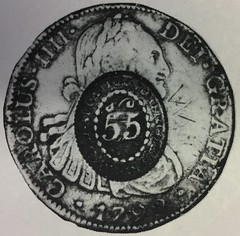 "I cannot thank your readers enough for the magnificent response to my request. I have reviewed all the information received and can say that I have recorded it all before. The 1799 host Ted provided is from earlier editions of various Krause catalogs dated 1978, 1986 and 1997. The one I am after is also 1799 but from Krause 1999. It is that relevant Krause page I am after. I enclose a very poor photo of what I believe the Krause 1999, 2nd edition 1801-1900, page 729, under Ireland, should show."
"I cannot thank your readers enough for the magnificent response to my request. I have reviewed all the information received and can say that I have recorded it all before. The 1799 host Ted provided is from earlier editions of various Krause catalogs dated 1978, 1986 and 1997. The one I am after is also 1799 but from Krause 1999. It is that relevant Krause page I am after. I enclose a very poor photo of what I believe the Krause 1999, 2nd edition 1801-1900, page 729, under Ireland, should show."
Here are Ron's remaining links. -Editor
To read the complete article, see:
GASTLEGOMER TOKENS: AN INOUIRY
(https://www.britnumsoc.org/publications/Digital%20BNJ/pdfs/1965_BNJ_34_21.pdf)
THE CASTLE COMER COLLIERY TOKEN
(https://www.britnumsoc.org/publications/Digital%20BNJ/pdfs/1962_BNJ_31_18.pdf)
Lot 614 IRISH COINS, Tokens, Co KILKENNY, Castlecomer, a plated counterfeit MEXICO, Charles IIII, 8 Réales
(https://www.numisbids.com/n.php?p=lot&sid=1888&lot=614)
Castlecomer Colliery Tokens c.1800
(https://www.facebook.com/media/set/?set=a.953967818011390.1073741839.476470342427809&type=3)
Ireland, Co. Kilkenny, Castlecomer Crown
(https://web.archive.org/web/20160414214442/http://www.irishcoins.com/?id=5398)
Thanks, everyone! -Editor
To read the earlier E-Sylum article, see:
NOTES FROM E-SYLUM READERS: JANUARY 16, 2022 : Query: 8 Reales Countermarked for Castlecomer Image Sought
(https://www.coinbooks.org/v25/esylum_v25n03a17.html)
WEGEFARTH'S GOLD AND SILVER DOLLAR SALOONS
Julia Casey submitted these notes on Gus Wegefarth's Gold and Silver Dollar Saloons in Buffalo, NY. Thanks! -Editor
I read about the Gold and Silver Dollar Saloons in Buffalo and wanted to pass along what I found in an article published in the Buffalo Commercial (June 26 1919). This article included the attached illustration, unfortunately it is not the clearest of scans but it shows some events in the history of the saloons. One scene depicts a man on the floor with a cutting tool and the caption "A FAVORITE INDOOR SPORT OF THOSE DAYS" Digging silver dollars from the floor at Wegefarth's." Others note that "A huge replica of a dollar was imbedded in the sidewalk in front of the place" and "The bar was dotted with gold pieces."
There is also mention made to Wegefarth's suicide. I found this event reported in the November 4, 1907 Buffalo News. Gustavus Wegefarth was said to be 52 years old when he shot himself three times in the head at his home in Philadelphia. He was the manager of the Grand Opera House in that city at the time of his death. He was said to have been having financial difficulties and also suffered from lingering injuries as a result of a prior accident.
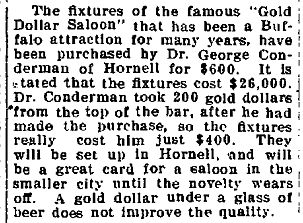 Earlier in 1907 newspapers reported that Dr. George Conderman of Hornell, NY had purchased the Gold Dollar fixtures at a bargain basement price of $600. Conderman was said to have removed $200 in gold pieces from the top of the bar so that his net expense was $400. The fixtures were described in the May 1, 1907 Jamestown Evening Journal as including "$2,800 worth of onyx and mirrors of fabulous value" along with "numerous other attachments of high value." Conderman was apparently surprised that he was able to afford the fixtures and did not have a plan for them except that he would take them to Hornell and possibly install them in his store on the new "Conderman Block" on Broad Street. The article stated that: "The gold dollars, of course, won't be restored to the counter, but it probably will be called the 'Gold Dollar.'" I have not been able to find any further information about what happened to the fixtures or if they are still located in Hornell.
Earlier in 1907 newspapers reported that Dr. George Conderman of Hornell, NY had purchased the Gold Dollar fixtures at a bargain basement price of $600. Conderman was said to have removed $200 in gold pieces from the top of the bar so that his net expense was $400. The fixtures were described in the May 1, 1907 Jamestown Evening Journal as including "$2,800 worth of onyx and mirrors of fabulous value" along with "numerous other attachments of high value." Conderman was apparently surprised that he was able to afford the fixtures and did not have a plan for them except that he would take them to Hornell and possibly install them in his store on the new "Conderman Block" on Broad Street. The article stated that: "The gold dollars, of course, won't be restored to the counter, but it probably will be called the 'Gold Dollar.'" I have not been able to find any further information about what happened to the fixtures or if they are still located in Hornell.
Regarding the coins that made up the decor of the saloons, the 1919 article states that:
"The Gold Dollar went on the rocks as far as Gus was concerned and he got out. In more than one way did he lose money. Try as he would to prevent it, dollars disappeared from the floor and from the bar. Whether friends took them as souvenirs or whether they were taken by thieves, they disappeared."
This 1919 article also said that Wegefarth came to Buffalo in 1884 and purchased the Silver Dollar Saloon and he then remodeled it and added the inlaid coins. He later sold the Silver Dollar Saloon and purchased and remodeled the Gold Dollar Saloon. The article implies that Wegefarth conceived the idea of adding the coins to the decor - this would seem to contradict the 1870 date for the presence of the coins in the saloons. But I was not able to spend the time yet to fully research this.
To read the earlier E-Sylum articles, see:
GOLD DOLLAR SALOON OPEN ON NEW YEAR'S DAY
(https://www.coinbooks.org/v25/esylum_v25n01a08.html)
NOTES FROM E-SYLUM READERS: JANUARY 9, 2022 :
Wegefarth's Gold and Silver Dollar Saloon
(https://www.coinbooks.org/v25/esylum_v25n02a08.html)
ELIASBERG 1850 BALDWIN & CO. $5 REDISCOVERED
Ron Guth is the Chief Investigator at the Numismatic Detective Agency, and this week he published a blog article on a recent discovery - a Baldwin & Co. gold piece from the Eliasberg collection. Nice find! -Editor
Recently, a client asked me to track the provenance on his 1850 Baldwin & Co. $5. Heritage Numismatic Auctions sold the coin -- in a PCGS MS61 holder with a CAC sticker -- as part of the Buffalo Bayou Collection in the January 2022 F.U.N. Sale (lot 4490). The catalog description listed a prior provenance to the Riverboat Collection, also sold by Heritage in April 2014. No additional prior provenance was offered. Since this was a significant condition-rarity example, the client was curious to know if the coin had appeared in any earlier sales. Rarities like this seldom just pop up out of nowhere, so a search is warranted.
Auction records for the 1850 Baldwin & Co. $5 are sparse, as might be expected for a Rarity 5 Pioneer gold coin, but there were several clues that narrowed the field. NGC reports an MS64 example – too nice to be this coin. PCGS reports a second MS61, but that coin has a big rim cud at upper right – something this coin does not have. Superior sold a raw MS60 in 1988, but that's now the second PCGS MS61 with the rim cud. Kreisberg & Cohen sold three Uncs. in the 1975-1980 period, but that was after Eliasberg stopped collecting. Stack's sold a raw Unc. as part of the J.F. Bell collection in 1944, but that coin is now in an AU55 holder. The Unc. details, cleaned example sold by Heritage in August 2011 didn't match, nor did the raw AU58 sold by Stack's in January 2007. The next level down was a group of five PCGS AU55s sold at various times from 2002-2017, but they also did not match the client's coin. Finally, there was the raw AU55 sold by Bowers & Merena as part of the Eliasberg collection in 1996. Below AU 55, the chances of making a match began to dwindle considerably.
I almost missed the Eliasberg match (sort of like having your 8 pound test line snapped by a 22 pound bass). The image in the 1996 catalog was not all that clear and the grade mis-match was almost too great. However, upon closer examination, there were enough matching markers to make a positive identification (see image above).
Upon hearing the news, my client was understandably surprised and pleased. Having a connection to the Eliasberg provenance is an important cachet for any coin. This was a big one that didn't get away.
Provenance research can often be boring and unfruitful, but discoveries like this make it all worthwhile. Thus, I'd like to modify the angler's saying to this:
A bad day researching coins is better than a good day at work.
P.S. There's a possibility that the provenance of this coin goes back even farther. The image of Lot 60 in Henry Chapman's 1924 sale of the Arthur C. Nygren collection has some matching markers, most notably the weakness in the denticles below the date, but there are not enough matches to reach a 100% confidence level. For now, I'll leave it at possibly Nygren.
To read the complete article, see:
The Eliasberg Project: Rediscovering the 1850 Baldwin & Co. $5
(https://numismaticdetectives.com/blog/f/the-eliasberg-project-rediscovery-of-the-eliasberg-1850-baldwin)
NOTES FROM E-SYLUM READERS: JANUARY 23, 2022
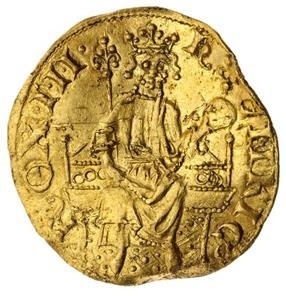 Gold Penny of Henry III Die Types
Gold Penny of Henry III Die Types
Martin Purdy of Upper Hutt, New Zealand writes:
"I was struck by the shape of the E in REX in this piece, compared to the E in HENRIC, for example - it looks more like an O with a partial horizontal line added. Despite only eight examples being known, I've found three different forms of that letter on this denomination in a quick web search, one a more traditional Lombardic E and another looking more like a couple of superimposed S's. The original mintage must have been relatively large, given the existence of multiple die types, so I wonder how many more escaped the melting pot."
Good question. Time will tell! To read about the metal detectorist who found it, see an article elsewhere in this issue. -Editor
To read the earlier E-Sylum article, see:
A NEW GOLD PENNY OF HENRY III
(https://www.coinbooks.org/v25/esylum_v25n03a24.html)
More on Puebla de Los Angeles
Last week I wondered if this piece listed in the 1892 book by Alejandro Rosa was from the place we know today as Los Angeles, CA. -Editor
Michael Wehner of San Francisco writes:
"This very question about whether Puebla de Los Angeles is the California city came up recently in a discussion with Federico Castillo about a medal that Hedley Betts had on his website."
Michael continues:
"In this case, Puebla de Los Angeles refers to the city of Puebla in the state of the same name in Mexico, not in present day California. It also known as the city of Angels. The medal we were researching is listed in "Medals of Mexico, by Frank Grove" as C-139."
Federico Castillo writes:
"The population of LA during Carlos IV reign was no more than 1000 and not economically important. Unlikely to have issued such a medal."
Thank you. Early American numismatics doesn't begin and end with the 13 original colonies. The well-known Texas Jola and Syd Martin's recent book on French Coinage Specifically for Colonial America attest to that. I was curious to know if there were early numismatic items attributable to California. -Editor
To read the earlier E-Sylum article, see:
NOTES FROM E-SYLUM READERS: JANUARY 16, 2022 : Query: Is This Piece From Los Angeles, California?
(https://www.coinbooks.org/v25/esylum_v25n03a17.html)
U.S. Sanitary Fair Numismatics
Mitch Fraas writes:
"If anyone is interested in the numismatic history of Civil War fundraising, there are several examples of coins and medals sold to benefit the war effort as part of the U.S. Sanitary Fair movement. I was reminded of this seeing a bookdealer's offering of the catalog to the coins sold to benefit the Western Sanitary Fair in Cincinnati in 1864. I know there were coins and medals exhibited here in Philadelphia. the Philadelphia fair had a machine on display from the mint which produced tokens for attendees (these are Baker-363a I believe). The New York fair had at least one coin on sale in their curiosity shop."
Thanks. Mitch provided a number of links. -Editor
To read the Cincinnati sale catalog on NNP, see:
Priced catalogue of a large collection of autographs, coins, medals, etc., donated to the Great Western Sanitary Fair, to be sold at auction for the benefit of the Cincinatti branch of the U.S. Sanitary Commission, by S.G. Hubbard, at ... Cincinatti ... [03/15/1864]
(https://nnp.wustl.edu/library/auctionlots?AucCoId=510983&AuctionId=520276)
For more information, see:
Philadelphia's Civil War sanitary fairs
(https://philadelphiaencyclopedia.org/archive/civil-war-sanitary-fairs/)
Catalogue of articles contained in the museum and curiosity shop of the Metropolian Fair April 4th, 1864
(https://babel.hathitrust.org/cgi/pt?id=loc.ark:/13960/t3gx4q20c&view=1up&seq=5&skin=2021&q1=coin)
Retiring and Quickly Un-Retiring
Alan V Weinberg writes:
"I found Dave Alexander's comments, expanded from a Coin World Guest Commentary, on Harvey Stack's passing particularly intriguing when he comments that the (unnamed) firm in California that purchased Stack's Bowers - that their employees wondered who Harvey Stack was ( ! ) over the furor of his re-hiring.
"Yes, re-hiring
. When Spectrum acquired the StacksBowers firm, Spectrum actually fired HGS and QDB. This status was short-lived as there was such an uproar in the numismatic community worldwide that these men were
re-hired as, at the very least, their presence was crucial to attracting
future consignments. Spectrum could not understand that."
Sad, but true. A bizarre but thankfully brief episode. -Editor
To read the earlier E-Sylum articles, see:
HARVEY AND LAWRENCE STACK REJOIN STACKS-BOWERS
(https://www.coinbooks.org/esylum_v14n22a10.html)
NOTES FROM E-SYLUM READERS: JANUARY 16, 2022 :
More on Harvey Stack
(https://www.coinbooks.org/v25/esylum_v25n03a17.html)
Whitman Coin Printing Blocks
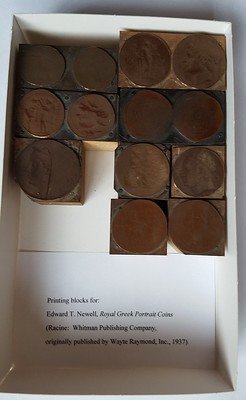 Bruce Bartelt writes:
Bruce Bartelt writes:
"The printing blocks Dr. Kraft enquires about look very much like some that I purchased a few (6-7?) years ago from a Racine coin dealer at a local coin show. They apparently were disposed of when Whitman closed their Racine operations. The dealer had several dozen; I picked out a few with ancient coin images that were used for Edward Newell's book Royal Greek Portrait Coins as published by Whitman. Unfortunately, I cannot make a match with those Dr. Kraft's correspondent has. The Red Book and Blue Book don't use overlapping images as far as I have found, and I've checked a couple other Whitman books without luck. I suppose they could be from a completely different publisher, but it is an interesting coincidence.
"I've attached images of a few of mine."
Neat - great to be able to match up illustrations with the printing plate. Nice exhibit material.
These Whitman printing blocks have come up in The E-Sylum before. -Editor
To read the earlier E-Sylum articles, see:
MORE WHITMAN COIN IMAGE PRINTING PLATES
(https://www.coinbooks.org/esylum_v17n06a15.html)
QUERY: COIN PRINTING BLOCKS
(https://www.coinbooks.org/v25/esylum_v25n03a15.html)
Paris Mint Strikes of the John Paul Jones Medal
John Kraljevich writes:
"The US Mint didn't have the dies to the John Paul Jones medal in 1843 or for 20 years after that. That's a Paris Mint strike, probably of late 19th or early 20th century vintage. It should have a mark on the edge near 6:00 that would date it rather precisely."
Roger Burdette writes:
"Peale's 1843 list of medal dies is clear that the original Jones (and Washington) dies were in Paris; however, it is obvious that he was making electrotypes and copy dies to supply the US market."
Peter Jones writes:
"I read with interest Robert Whitehead's note that he is collecting Comitia Americana medals — a great and historic series to collect. The best reference I have found is The Stacks Bower's Auction Catalog of John Adams' Comitia Americana medals in November 2019. Written by John Kraljevich, it covers 110 lots in 133 pages with a lot of detail and historical background."
Thanks, everyone. And don't forget Peter's own book on Comitia Americana medals, The First Medals of America. It contains a chart of all the different types of medals (which can be quite confusing), how many are known, and their price ranges. See the earlier article linked below for more information. -Editor
To read the earlier E-Sylum article, see:
GILT JOHN PAUL JONES MEDAL
(https://www.coinbooks.org/v25/esylum_v25n03a16.html)
The "Prince Andrew Commemorative Coin"
Arthur Shippee shared this topical "Prince Andrew commemorative coin". Thanks. -Editor
THE BOOK BAZARRE
WHO WAS J. M. WALKER?
J. M. Walker's $1 and $3 Gold Buying Guide
Knowing that we enjoy numismatic ephemera, Roger Burdette passed along his January 23, 2020 post on the NGC Forum about an unusual circa 1900 gold coin buying guide. -Editor
Enterprising coin dealer J. M. Walker had the idea to distribute a card & envelope combination soliciting purchase of $1 and $3 gold coins from merchants and bankers. In early 1900 he wrote to the Mint Bureau requesting permission to quote mintage quantities for both coins on his promotional card. He was told it was OK to do, and when printing was complete he sent the mint a sample. The 3x5 card is two-sided and intended to be attached to a similar sized envelope. Merchants could put any gold they found in the envelope and send it to Mr. Walker for his "good premium" offer.
Interesting. I wondered if anyone could tell us more about Walker. Did he produce other coin buying guides? Fixed price lists? So I reached out to regular contributor Pete Smith, author of American Numismatic Biographies. Here's what he found. -Editor
The 1900 Census shows Joshua Walker living at 223 Railroad Street in New Bethlehem, Pennsylvania. Today that street is adjacent to an abandoned railroad line that also runs along Arch Street. Perhaps the name changed or perhaps the census taker was confused.
The Census shows that Joshua was born in April 1851, and married Lucy in 1873. His occupation was listed as foreman at a saw mill. The 1880 Census gives his occupation as carpenter. The 1910 Census gives his name as J. Marlin Walker, now on Arch Street and working as a foreman in a planing shop.
In 1895, Walker placed an ad in Frank Leslie's Popular Monthly, offering Fossil Fish
and indicating that he was a dealer in minerals. The address at 223 Arch Street indicates that name was in use before the 1900 Census.
That same year he placed an ad in The Chatauquan offering free samples as a dealer in minerals. Based on his Census records, this was a side hustle and not his regular job.
There are other scattered records that add little to his story. He was not a significant coin dealer.
Thanks, everyone. Interesting numismatic sidelight. -Editor
To read the complete discussion thread, see:
J. M. Walker - Buying $1 and $3 Gold
(https://boards.ngccoin.com/topic/419199-j-m-walker-buying-1-and-3-gold/)
NEW REPORT EXAMINES U.S. MINT RACIAL TENSIONS
The New York Times published an article about a new report on racial tensions at the U.S. Mint. This is not a new topic - see the earlier article linked below. -Editor
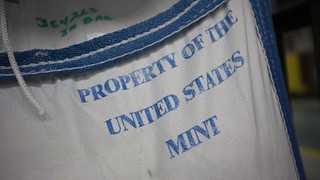 The United States Mint celebrated a milestone this month when it announced the first shipment of a new batch of quarters bearing the image of the writer and poet Maya Angelou, the first Black woman to be depicted on the 25-cent coin.
The United States Mint celebrated a milestone this month when it announced the first shipment of a new batch of quarters bearing the image of the writer and poet Maya Angelou, the first Black woman to be depicted on the 25-cent coin.
The announcement came weeks after President Biden said he would nominate Ventris C. Gibson to lead the Mint, where, if confirmed, she would serve as its first Black director.
But beneath the public signs of social progress is an agency that has struggled for years with racial tension, with Black employees saying they feel threatened, marginalized and professionally disadvantaged. While instances of racism at the Mint have surfaced in previous years, a new internal report that was reviewed by The New York Times depicts an institution rife with tumult over allegations of racist behavior.
Participants in a survey conducted by the consulting firm, which included more than 200 staff members, senior managers and executives, said race was a divisive issue at the Mint. Many people at the agency expressed concerns that hiring and promotions for people of color were not handled fairly and said they feared reprisal for making formal complaints.
The firm, TI Verbatim Consulting, said in the report that its findings point to potential root causes for the racial divide
at the Mint. The report cited outdated policies, cliques, ambiguous promotion practices and the perception of favoritism. Although some members of the Mint's work force described a positive environment, others said there had been a noticeable downward spiral
in recent years amid growing racial tension and as acts of overt discrimination surfaced.
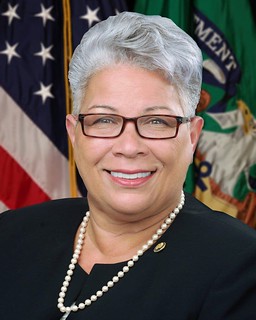 Before Mr. Biden announced her nomination to lead the Mint, Ms. Gibson was appointed in October as the agency's deputy director. At the time, Wally Adeyemo, the deputy Treasury secretary, hailed her selection as a sign of progress.
Before Mr. Biden announced her nomination to lead the Mint, Ms. Gibson was appointed in October as the agency's deputy director. At the time, Wally Adeyemo, the deputy Treasury secretary, hailed her selection as a sign of progress.
Her historic appointment reflects our ongoing commitment to building a qualified, diverse work force at Treasury and its bureaus that will serve the American people well,
he said.
The Mint historically was a place that pioneered diversity but did not always prioritize healthy working conditions. In 1795, it became the first federal agency to employ women when it began hiring them to work in the so-called adjusting room, a poorly ventilated space where they would weigh and file down blank coins.
In recent years, bringing diversity to the imagery on America's coins has been a priority for the Mint. The bipartisan Circulating Collectible Coin Redesign Act of 2020, which President Donald J. Trump signed into law the week before he left office, initiated the addition of notable women, such as Ms. Angelou, on quarters through 2025.
The findings of the report have yet to be released publicly. They are expected to be shared more widely within the Mint's staff this month, Ms. Gibson said in her statement.
To read the complete articles, see:
Racial Turmoil Mars Signs of Progress at the U.S. Mint
(https://www.nytimes.com/2022/01/21/us/politics/us-mint-racial-turmoil.html)
Black employees at U.S. Mint feel marginalized and threatened, report says
(https://www.cnbc.com/2022/01/21/black-employees-at-us-mint-feel-marginalized-and-threatened-report-says.html)
To read the earlier E-Sylum article, see:
MINT EMPLOYEES ALLEGE RACIAL HARASSMENT
(https://www.coinbooks.org/v23/esylum_v23n38a24.html)
VOCABULARY TERM: HEADER, HEADER BAR
Here's another entry from Dick Johnson's Encyclopedia of Coin and Medal Terminology. -Editor
Header, Header Bar. The top portion of a multielement medal or badge, usually the portion with the pinback or other fastener from which all other elements are suspended. The header bar contains some means from which other elements are suspended, as one or more loops, or a ribbon fob. The header is generally in horizontal format, but it can be any size or shape; it is often highly decorated and silhouetted. It is designed to supplement the theme of the medal or badge, customarily a pendant medal. Headers can be struck or cast, can be solid or thin struck as a shell; since the item is intended to be worn, shell headers have the advantage of lesser weight.
Headers are quite versatile in that they can be customized, either by some means of displaying a nametag for each badge, or by its inscription for several classes (as each official can have a header inscribed with his title). But the two most important functions of a header is to provide a means of attachment to a garment – usually by stem and clasp – and by the top element from which all other components are suspended.
The pendant medal can be suspended from the header or header bar by means of a jump ring connecting loops on both items. Or the pendant can be connected by chain. Or the header may support a ribbon, alone or from which the pendant is suspended, or in back of the pendant suspension. The design of medals, badges and their suspension is quite variable to suit the needs of the occasion.
Some headers are stock designs, suitable for many uses. Others are custom designed only for one use, highly decorated and embellished with designs appropriate to the event requiring the medal or badge. Most headers have the name of their maker on the reverse, a maker's mark, symbol or logo. Some headers support drops in addition to other suspended elements.
Often, years later, the header may become separated from the remainder of the item. This occurs when, perhaps, the chain or jump ring breaks, or the ribbon wears and breaks away. Such separate headers have come on the secondary market in this fashion.
Should a header not be used for a multielement medal or badge, particularly one with a ribbon, the fastener can be hidden behind the ribbon with a concealed bar.
To read the complete entry on the Newman Numismatic Portal, see:
Header, Header Bar.
(https://nnp.wustl.edu/library/dictionarydetail/516044)
FERNAND DAVID (1861-1927)
Monaco auction house Editions Victor Gadoury is offering the collection of Fernand David in a March 2022 sale. The catalogue contains a profile of the collector (in French) by Alain Weil. Here's a Google-translated version (with some minor additional edits). It's rough, but provides an interesting portrait of an important collector. It's remarkable that so much of his collection remained intact until today. -Editor
1861 - 1927
Revealing a collection
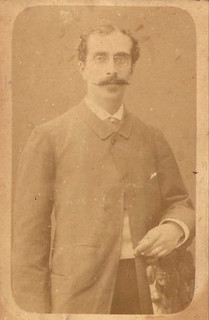 The collection that I have the honor to present, in collaboration with my friends and colleagues Pastrone, is one of the finest entrusted to me in my long career. It is also one of the most mysterious. It belongs to two sisters who are, on the maternal side, the granddaughters of a famous collector in his time, Fernand David. Unfortunately, very little information about the life of this numismatist has come down to us.
The collection that I have the honor to present, in collaboration with my friends and colleagues Pastrone, is one of the finest entrusted to me in my long career. It is also one of the most mysterious. It belongs to two sisters who are, on the maternal side, the granddaughters of a famous collector in his time, Fernand David. Unfortunately, very little information about the life of this numismatist has come down to us.
Curiously, this collection leaves an impression of being unfinished despite the quality and rarity of its coins. It seems to have the ambition to tackle a very large number of areas (ancient coins, French, foreign, tokens, badges, medals, etc…) but leaving inexplicable gaps in many of them. Thus, in ancient coins, Greece is almost absent and Gaul is represented by only two coins whereas the Roman coinage impresses with its long series of rare and superb aurei. For feudal coinage, Lorraine shines with more than twenty gold coins while other provinces are very poorly represented or even completely absent, such as Brittany. We find such oddities for French and foreign gold coins as well as for silver coins.
In short, we can wonder if Fernand David did not find himself short of means by wanting to expand his collection too much. It is unlikely because he was one of the owners of A. David Frères, a factory extremely prosperous in trimmings, lace and embroidery. The medals of international or universal exhibition awards attributed to this company testify to its importance and its notoriety: silver medal in Paris in 1889, out of competition in Chicago in 1893, gold medals in Amsterdam in 1895, in Brussels in 1897 and at the Great Universal Exhibition of 1900 in Paris (group 13, class 84: Lace, Embroidery, Trimmings).
Moreover, his collection was known both in France and abroad. The precious Gnecchi brothers Guida Numismatica Universale cites him (p. 145) alongside Prince Napoleon or the Comte de Castellane as a collector with a "very rich collection of Roman coins, Gallic and French. In our country, Fernand David does not seem to have practiced a policy of secrecy as many collectors do. On the contrary, as an active member of the Société Française de Numismatique (SFN), he often shared his findings and research there by entrusting directly to Paul Bordeaux the task of presenting them.
The pages of the Revue Numismatique bear traces of about twenty communications. In one of them, is described a unicum: the shield of Dauphiné with insignia struck in 1702. Not having found this coin in the collection, I opened up about it to Christian Charlet with the hope that his encyclopedic knowledge would help me find a clue. I was not disappointed because he traced for me, after a few days, the complex journey of this piece that Paul Bordeaux had presented to the S.F.N. in 1900. After more than half a century, the shield is found in London in the sale of the collection of Wayte Raymond (1963) where it was acquired by Jean Vinchon on behalf of Montalent, whose collection was sold by the same expert in December 1977. The 1702 shield was then purchased by the Banque de France for its collection where it resides currently.
Esteemed by his fellow collectors, Fernand David was also respected by scholarly numismatists. A charming testimony to this is the witty letter that Adrien Blanchet wrote to him, beginning his letter with the words My dear Confère et ami
. When the president of the S.F.N. will make
account of his death, he will underline "the greatest modesty and the inexhaustible kindness" of one of the foremost members of the Society.
As for the mystery of the composition of the collection, it was lifted thanks to family explanations reporting a theft of a large part of the coins during the last war. This information finally reveals the true nature of the current collection: Fernand David has, if I dare say, done in the lace to constitute the original collection, he surely bought with attention and refinement the best copies to seek universality, beauty, rarity. And, despite its shortcomings, the set offered today is the perfect reflection of this numismatic ideal that I invite you to share.
To download the catalogue, see:
https://www.gadoury.com/auctions/docs/Asta-fernand-david-lowdef.pdf
HARVEY STACK'S NUMISMATIC FAMILY, PART 113
Good news for fans of the late Harvey Stack's numismatic memoirs - Stack's Bowers has a backlog of articles and will continue publishing them. In this one he discusses an unfortunately not uncommon 1993 incident that fueled his longtime rage against the marketing practices of the U.S. Mint. -Editor
Harvey Stack loved to tell stories and his favorites were those about his family and the history of Stack's. While he passed away on January 3 of this year, he had already penned his remembrances through 1999. We believe Harvey would want these articles to be read and enjoyed and so we are pleased to continue the story of his life in numismatics.
1993 was an important anniversary year for Stack's as it marked 60 years since Joseph and Morton Stack opened their numismatic retail store in New York City. It was also the 40th anniversary of the opening of the shop on West 57th Street, where the company was located after having expanded and moved a couple of times in the 20 intervening years. Over time, Stack's, at whatever address, was considered a clubhouse for coin collectors, a place to buy and sell, to meet with fellow enthusiasts, and to use the extensive library the firm had built up over the years. All of us in the Stack family welcomed those who walked through the door, not just as buyers and sellers, but also as fellow numismatists who took the time to teach us what they had learned in their years of collecting.
The numismatic market continued to recover from 1987's downturn and Stack's was able to buy a number of collections and help our clients acquire important additions to enhance their collections. Our auction consignments also grew this year and we were able to offer some 10 collections, comprising single owner sales, estate collections, and auctions that brought together multiple consignments that were not large enough to require a dedicated catalog.
One downer on the numismatic market was some unhappiness expressed by collectors of all levels as well as investors about the series of commemorative issues that numbered in the hundreds of thousands and had been sold at premiums far in excess of their precious metal value. These were offered by the U.S. Mint and were sold using promotional material and advertisements that included the phrase "An Investment in the Future." The endorsement of the Mint attracted many who did not fully understand what they were buying. Such buyers often used these products as gifts for family members or friends, thinking that they would be a great investment. But by 1993, when some of these purchasers tried to sell these prizes they had bought from the Mint, the investment turned out to be not so great.
I offer as an example a lovely grandmother who in 1983 responded to the advertising of the U.S. Mint and bought one each, as they were offered, as an investment for her grandson. When in 1993 the grandson need money to go to college, grandma offered to sell the "collection" and give the money to him for his education. She told me that she had invested about $5,000 in what she had, and wanted to sell them to Stack's. I examined all the coins, some loose, some in cardboard holders, and a few in boxes, and computed what I could pay for them. I knew it would be quite a bit lower than her original cost as gold and silver prices did not rise or fall much during this period and the "coins" would only be worth their current collector value.
I went to the charts we maintained showing the current buying and selling prices, both below her original cost. Using the highest prices quoted in the newsletter we received daily, I was embarrassed to only be able to offer her $2,210. She was stunned -- after all to her these were sold to her by the Mint as "investment items." She must have thought I was trying to rip her off, so she gathered her coins together and left the shop. A few days later she returned and asked if my offer was still good. I told her it was. She informed me that she had visited about half a dozen shops around the city and the best offer she received was $2,100, most were less and in general, no one was very interested in buying them at all. I wrote her a check and she thanked me. This was not the first or last time that this happened, and it was a situation that really bothered me. I realized that so many neophyte buyers, gift buyers and even collectors could be misled by the Mint and its salesmanship. I felt that the hobby and professional dealers like Stack's would lose more collectors due to these new issues than would be gained.
This was so upsetting to me that I sought help to see what could be done. Over the course of my career, I had gained experience dealing with the government as well as working within various organizations to make changes that would benefit the hobby. From bringing action against the Treasury to stop import restrictions on gold to advising on the Hobby Protection Act I had the opportunity to campaign for the benefit of numismatics. I had worked with the ANA on grading standards and served on the board of the Professional Numismatic Guild (PNG) as well as acting as its president. My appointment to the 1976 United States Assay Commission (the last one convened) also gave me some contacts within the government and the Mint.?
Stack's had a good client and friend in Jimmy Hayes, who was a representative to Congress from Louisiana during this period. I discussed the entire matter with him and asked if he could offer any guidance to reach the right official at the Mint and explain the "special issue " situation and my concerns. He said he would do what he could. A few months later, Jimmy told me that he could arrange for me and others to appear before the House of Representatives Banking and Finance Committee. He said it might take a year to get this hearing, but it would be done, and the matter would be heard by a higher authority. As it was not my first time dealing with the government, I was not surprised to hear that it would take time, but I felt I had found a way to get my message across.
To read the complete article, see:
Growing up in a Numismatic Family: Part 113
(https://www.stacksbowers.com/News/Pages/Blogs.aspx?ArticleID=growing-up-in-a-numismatic-family-part-113)
To read the earlier E-Sylum article, see:
HARVEY STACK'S NUMISMATIC FAMILY, PART 112
(https://www.coinbooks.org/v25/esylum_v25n01a17.html)
HARVEY G. STACK (1928-2022)
(https://www.coinbooks.org/v25/esylum_v25n02a04.html)
NYT: HARVEY G. STACK DIES AT 93
The New York Times published an obituary of Harvey this week. Here's an excerpt - see the complete article online (and spot the errors...) Thanks to Arthur Shippee for passing this along. -Editor
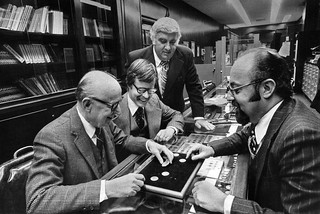 Harvey G. Stack, the patriarch of the family firm that bills itself as the nation's largest rare coin business, died on Jan. 3 in New York. He was 93.
Harvey G. Stack, the patriarch of the family firm that bills itself as the nation's largest rare coin business, died on Jan. 3 in New York. He was 93.
His death was confirmed by his son, Larry.
Mr. Stack joined Stack's Rare Coins as a teenager in 1947, 14 years after his father and uncle transformed what his great-grandfather had founded in 1858 as a foreign exchange house in Lower Manhattan into a dealership devoted exclusively to collectible currency.
I had worked virtually every moment that I wasn't in school,
he wrote in a history for the company.
The firm begun in the 19th century by his great-grandfather Maurice got into numismatics as a sideline, buying and selling collector coins and currency in addition to its primary function in foreign exchange.
He drew a distinction between coin collectors, whom he courted assiduously, and investors.
If a collector and an investor had to abandon a sinking ship, the collector would take with him the rarest and most aesthetically appealing pieces without regard to market value,
he told The Times in 1977. The investor would try to take as much of his coins as possible, starting with the most valuable.
To read the complete article, see:
Harvey G. Stack, Leading Dealer in Rare Coins, Dies at 93
(https://www.nytimes.com/2022/01/22/business/harvey-g-stack-dead.html)
DAMSTRA ON DESIGNING MAYA ANGELOU QUARTER
I misplaced this article or would have included it last week along with the piece on the new Maya Angelou Quarter. A Michigan television station interviewed the coin's designer Emily Damstra. -Editor
A West Michigan native is the artist behind something people across the country will have in their pockets and on their dressers.
Emily Damstra is the artist who created the image on the brand-new Maya Angelou coin.
I was very excited. I was ecstatic,
Damstra said when she learned her art had been chosen to be on the first coin released in the American Women Quarters Program.
Now living in Canada, Damstra's love of art started here in West Michigan nurtured by her mother and teachers at Forest Hills Northern.
I had an excellent high school art teacher, Sue Rose, who was just an exceptional instructor and a great role model as well. And I also remember learning the fundamentals of drawing light on form from Mrs. Quigley in middle school,
Damstra said.
Specializing in detailed illustrations of nature, Damstra applied and was chosen to be part of the United States Mint Artistic Infusion program, a group of artists who produce designs for coins.
I always start a coin design like this by doing a lot of research,
Damstra said.
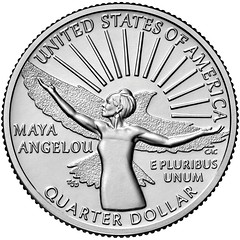 Damstra re-read
Damstra re-read I Know Why the Caged Bird Sings,
read a lot of Angelou's poetry and reviewed a bunch of images of her.
I was really inspired by Maya Angelou and her remarkable life. And I wanted to do a design that was uplifting like so much of her life and her political and social activism was,
Damstra said.
You'll see that uplifting spirit in Damstra's design including the bird and sun images from Angelou's writing. Damstra gives credit to her parents for always supporting her dream to be an artist and has advice for anyone else who wants to go for it.
You really do have to have a lot of self-discipline to be an artist, and of course I would recommend, practice, practice, practice,
Damstra said.
To read the complete article, see:
W. MI native is artist behind new Maya Angelou coin
(https://www.woodtv.com/news/national/w-mi-native-is-artist-behind-new-maya-angelou-coin/)
To read the earlier E-Sylum article, see:
MAYA ANGELOU QUARTER NEWS COVERAGE
(https://www.coinbooks.org/v25/esylum_v25n03a18.html)
LIPSON HEADS OTTAWA NUMISMATIC SOCIETY
Canadian Coin News published an article about Jacob Lipson and his presidency of the Ottawa Numismatic Society. With permission, we're republishing it here. Congratulations! -Editor
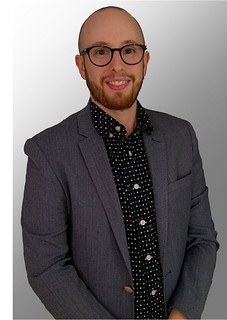 Montréal dealer Jacob Lipson, the owner of Jacob Lipson Rare Coins, has been installed as the new president of the Ottawa Numismatic Society (ONS).
Montréal dealer Jacob Lipson, the owner of Jacob Lipson Rare Coins, has been installed as the new president of the Ottawa Numismatic Society (ONS).
Steve Woodland, the society's past president, handed the reigns to Lipson during a Dec. 20 virtual meeting. He's joined on the ONS executive by Treasurer Wilf Lauber and Secretary Randy Marquette.
Lipson has more than a decade of experience as a professional numismatist, including as an independent consultant with the Texas-based Heritage Auctions. Through his firm, he offers Canadian and U.S. decimal coins plus a wide variety of scarce historical medals. He's also a member of the Royal Canadian Numismatic Association, Ontario Numismatic Association, Montréal Numismatic Society, Lakeshore Coin Club, Association de Numismates et Philatelistes de Boucherville, American Numismatic Association, Numismatic Literary Guild and Medal Collectors of America (MCA), the latter of which he serves as a board member.
A graduate of McGill University, Lipson received the MCA's Georgia Stamm Chamberlain Award in 2018 for his work in medallic art research. He became interested in medals after seeing a gold medal in the school's collection, spurring him to publish an article, The McGill University Hiram Mills Award Medal,
in the August 2018 Canadian Numismatic Journal.
To read the complete article, see:
Ottawa club names new president
(https://canadiancoinnews.com/ottawa-club-names-new-president/)
NYT FEATURES MILLENNIAL AND GEN Z COLLECTORS
Brooklyn-based illustrator Julia Rothman and writer / filmmaker Shaina Feinberg published a New York Times column on today's younger numismatists. Here's a sampling - see the complete article online. Excellent treatment! Congrats to all, including Lianna Spurrier, who we've featured before with her great videos and masterful hosting of the NNP Symposium. -Editor
To read the complete article, see:
They Love Coins (Just Not Bitcoin)
(https://www.nytimes.com/2022/01/21/business/coin-collecting-bitcoin-numismatists.html)
THE BOOK BAZARRE
FRANK ROBINSON AT THE NEW YORK INTERNATIONAL
I didn't make it to the New York International show this year, so in lieu of a Diary article here's an excerpt from dealer Frank Robinson's excellent blog post. Thanks for the report! -Editor
The New York International Coin Show is the premier event. It used to be each December; until 2001 when there was a little problem with the location — the World Trade Center. Organizers managed to scramble a new venue for January, so it's been January ever since. It started in 1972, was cancelled in 2021 due to Covid, but went ahead this year — the fiftieth. I've attended every one.
It's truly international, many dealers from overseas, which is what makes it great. Though fewer than usual this time, with Covid still inhibiting travel.
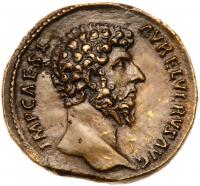 I go to buy; wasn't expecting to find much. Several dealers were remarking on how, in particular, it's getting impossible to buy from auctions, someone will always outbid you. Yet I came away with a good haul of worthwhile material. Even surprisingly a coin from one of the auctions connected with the show, a lovely Lucius Verus sestertius, for $480.* Looking much better in hand than the catalog photo; from the
I go to buy; wasn't expecting to find much. Several dealers were remarking on how, in particular, it's getting impossible to buy from auctions, someone will always outbid you. Yet I came away with a good haul of worthwhile material. Even surprisingly a coin from one of the auctions connected with the show, a lovely Lucius Verus sestertius, for $480.* Looking much better in hand than the catalog photo; from the New York Sale
run by a consortium of dealers. And Goldberg's cheerful Glenn Onishi delivered it to me personally, saving the shipping fee.
I spent a couple of hours with Robin Danziger of Educational Coin Company. Another guy I've known forever. I once visited their amazing Ulster County premises — imagine a Home Depot but filled with coins. Robin is someone who really loves them and their history. He had bags and bags I searched through, typically picking out a coin here and a coin there. Yes, I'm a careful, fussy buyer, very quality conscious.
Robin remarked that it was like selling to El Exigente.
Referring to an old TV coffee commercial. White-hatted, El Exigente (the demanding one
) is the buying agent, coming to a Colombian village. Frowning, he carefully inspects their coffee beans. Finally, a smile — and the villagers are joyful their harvest meets his exacting approval.
Examining some of my picks, Robin also commented, You have terrific taste in coins.
Well, flattering the customer never hurts. One bag was all posthumous small bronzes of Constantine I. Common — but not at all if well centered and struck, with complete legends.
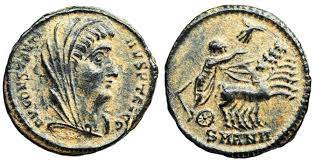 When I chose just one, Robin picked out another, saying surely it too should qualify. I agreed it was lovely in all respects — save the mintmark being missing. But then he did point out one other I accepted.
When I chose just one, Robin picked out another, saying surely it too should qualify. I agreed it was lovely in all respects — save the mintmark being missing. But then he did point out one other I accepted.
I wound up with a goodly pile of purchases that pleased both of us.
To read the complete article, see:
El Exigente at the NY International Coin Show
(https://rationaloptimist.wordpress.com/2022/01/22/el-exigente-at-the-ny-international-coin-show/)
Frank has just posted a new pricelist concentrated alphabetically between Cayman and Germany, with many examples of Chinese cash and German states coinage. -Editor
To visit Frank's website and pricelist, see:
http://www.fsrcoin.com/
http://www.fsrcoin.com/139.htm
LONG BEACH TYRANT COLLECTION U.S. TYPE EXHIBIT
Looking forward to the February Long Beach show, here's the press release for the planned exhibit of U.S. coins from the Tyrant Collection. It's a fabulous exhibit, well designed and showcased. Amazing collection of amazing coins. -Editor
The public will be able to see the superb type set of more than 400 U.S. coins from the acclaimed Tyrant Collection (www.TheTyrantCollection.com) for the first time on the West Coast at the Long Beach Expo collectibles show, February 17-19, 2022. The Expo will be held in Hall C of the Long Beach, California Convention Center, 100 S. Pine Ave.
"There are few cabinets as magnificent as the Tyrant Collection, a set of unmatched depth and quality," remarked Professional Coin Grading Service (PCGS) President Stephanie Sabin. "What a treat it will be for attendees to tour this U.S. type set collection. The last exhibit from the Tyrant Collection at the Long Beach Expo was two years ago, a magnificent $50 million display of U.S. gold Eagles, and it was easily one of the most popular collections ever exhibited at the show."
Collectors and enthusiasts who want to see the amazing display in person can receive $5 off admission tickets purchased at www.LongBeachExpo.com by using the code Tyrant22.
Ranging from 1793 to 1964, many of the historic coins in the upcoming, extraordinary exhibit are the finest known of their kind. The centerpiece will be the legendary King of Siam proof set which was originally presented in 1836 by the U.S. State Department to the King of Siam (now Thailand) as a gift on behalf of President Andrew Jackson.
The entire, incomparable exhibit, entitled ‘U.S. Type Coins from The Tyrant Collection,' is insured for $100 million,
said Ira Goldberg, CEO of Goldberg Coins and Collectibles, Inc. in Los Angeles, California. He is among those who have assisted the coins' owner in building the collection of U.S. world and ancient coins that is often described as the world's most valuable rare coin collection in private hands.
The display will cover all U.S. types and sub-types, circulation strikes and proofs, from 1793 Liberty Cap half cents through the 1907 Saint-Gaudens Ultra High Relief $20 and everything in between to 1964. It made its first appearance to tremendous acclaim at the 2021 Chicago World's Fair of Money®, and now will be seen for the first time on the West Coast,
explained Goldberg.
Although The Tyrant Collection owner wants to remain anonymous, he has been displaying portions of his ancient, world and U.S. coins for their educational value, one segment at a time, in a continuing series of themed exhibits that began at the Long Beach Expo in 2018.
A few of the many individual highlights of the type set exhibit include:
-
1793 S-1 Flowing Hair
Chain AMERI
large cent, graded PCGS SP65; - 1796 JR-1 Draped Bust, Small Eagle dime, PCGS SP67 CAC ex. Simpson Collection;
- 1797 O-101a Draped Bust, Small Eagle half dollar, PCGS MS66 CAC ex. Pogue Collection;
- 1795 Draped Bust, Small Eagle dollar, PCGS SP66, ex. Garrett, Hayes and Pogue Collections;
- 1796 BD-2 Draped Bust, No Star quarter eagle, PCGS MS65 ex. Jung Collection;
- 1804 1804 Draped Bust silver dollar Class I, PCGS PR67, in the King of Siam set;
- 1907 Ultra High Relief double eagle, PCGS PR68, ex. Augustus Saint-Gaudens estate.
While supplies last, detailed catalogs with information and superb illustrations about each coin in the exhibit will be available at the show.
Since 1964, the Long Beach Expo has been the leading, international trade show in the coin, currency, stamp and sports collectibles industry held by Expos Unlimited. For specific information about the February 2020 show, including hours and discounted admission coupons, visit www.LongBeachExpo.com .
ANA COURSE: NUMISMATIC DIGITAL IMAGE EDITING
A mini-seminar taught by Michael Kodysz at the 2022 Summer Seminar in Colorado Springs will cover the basics of digital image editing for numismatists. -Editor
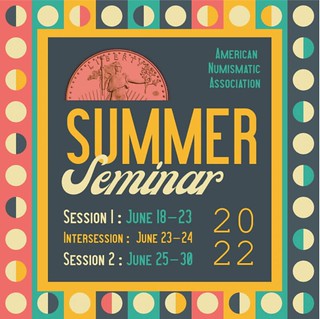 Digital Image Editing for Numismatics: Getting Your Obverses & Reverses Together is a new six-hour mini-seminar offered by the American Numismatic Association at the 2022 Summer Seminar in Colorado Springs. The mini-seminar course will cover the basics of digital image editing for collectors, dealers, authors, and researchers. While the course is geared primarily toward novices unfamiliar with the relevant software, all experience levels are welcome.
Digital Image Editing for Numismatics: Getting Your Obverses & Reverses Together is a new six-hour mini-seminar offered by the American Numismatic Association at the 2022 Summer Seminar in Colorado Springs. The mini-seminar course will cover the basics of digital image editing for collectors, dealers, authors, and researchers. While the course is geared primarily toward novices unfamiliar with the relevant software, all experience levels are welcome.
Attendees will learn how to organize, edit, and modify coin and paper money images for the purposes of print and web publishing, cataloging, personal reference, and exhibiting. Topics covered will include an overview of software options and the basics of Adobe Photoshop®; best practices for file organization, formatting, and image resolution; and a discussion of ethical guidelines.
Demonstrations will include the basics of color correction, how to add or remove backgrounds from images, and how to create special effects such as drop shadows and reflections. Students will gain hands-on practice in combining separate obverse and reverse photos of the same coin into a single seamless composite image. It is recommended that students bring their own digital images for hands-on practice, but practice images will also be provided by the instructor. It is highly recommended that students bring their own laptop with bring their own laptop with Adobe Photoshop® to familiarize themselves with the software.
Skills in digital image editing are essential for anyone interested in digital numismatic photography. The mini-seminar is held on Sunday and Monday evenings during Week II of Summer Seminar, so it can be taken in conjunction with the Advanced Digital Numismatic Photography for Collectors course held during the day.
INSTRUCTOR: Michael Kodysz, visual communication instructor and numismatic exhibitor
Session Two – Sun & Mon, July 5 & 6 Two Nights – 6 hours total 3 hours each night (6:30-9:30 p.m.)
Tuition: $79
Here are some examples of the types of things students will learn to do.
The 2022 Summer Seminar course catalog is available in PDF format directly from the ANA website here:
https://f.hubspotusercontent30.net/hubfs/6180285/Summer%20Seminar
%202022/Summer%20Seminar%202022%20Course%20Catalog.pdf
Online registration is available here:
https://www.money.org/summer-seminar/register
For a preview of what you can learn, see this video on the ANA's YouTube channel:
ANA eLearning Academy - Digital Image Editing for Numismatics
(https://youtu.be/Vmi-uXovqcc)
KÜNKER SALE 360: COLLECTION OF A CONNOISSEUR
Here's the press release for Künker's upcoming Auction 360. -Editor
Künker Presents the Collection of a Connoisseur
On 1 and 2 February 2022, Künker will hold its auction 360 as an eLive Premium Auction. It contains German coins and medals of top quality – with estimates from the two- to the four-digit range.
Although a coin has to fetch a six-digit result to make headlines in the daily press these days, the following statement still holds true: you do not need a lot of money to take pleasure in collecting coins. Künker's eLive Premium Auction 360 proves it. Estimates for highly interesting coins of perfect quality start at only 10 euros. Especially lovers of interesting fractional coins of the 18th and 19th centuries will find what they are looking for in this auction, even though there are obviously a lot of other treasures among the wide offer. It ranges from perfectly preserved coins from the Middle Ages to interesting talers and fractional pieces of the Holy Roman Empire to coins of the German Empire.
Medieval Coins from Europe
The auction starts with an interesting offer of medieval coins from Europe. The very first lot is extremely rare: a denarius by Pepin the Short, minted between 752 and 768 in Saint-Cirgues de Clermont-Ferrand. Via coins of Charlemagne, Edward the Confessor and the Hohenstaufen Emperor Frederick II, we move on to German bracteates with a focus on the area of Lake Constance, although iconic issues from Brandenburg, Halberstadt or Quedlinburg may obviously not be omitted either.
No. 1001: Carolingians. Pepin the Short, 752-768. Denarius, Saint-Cirgues de Clermont-Ferrand. Extremely rare. Very fine +. Estimate: 5,000 euros
No. 1047: Brandenburg. Albert the Bear, 1134-1157. Bracteate. Very rare. Extremely fine. Estimate: 1,500 euros
No. 1086: Überlingen. Bracteate, 1230-1250. Rare. Extremely fine +. Estimate: 500 euros
European Coins and Medals
Some very few European coins and medals are on offer too. Particularly interesting are the talers of the Holy Roman Empire and of the Austrian princes, some of them with exceptional patinas.
No. 1100: Rudolf II. Double reichstaler 1604, Hall. Extremely fine. Estimate: 1,000 euros
German States
With lot No. 1146 we have already arrived at the section of the German States, the main focus of this collection. No matter which field you are interested in – you will find fascinating objects among the more than 700 lots. Geographic focal points were laid on Baden, Bavaria, Brandenburg-Prussia, Brunswick, Saxony and cities in Southern Germany such as Augsburg, Nuremberg and Regensburg.
Particularly interesting is the abundance of small change in silver and bronze, all of which were gathered by the collector in perfect quality. But there is also a rich and interesting offer for lovers of taler-sized pieces with many coins that were issued for special occasions.
Browsing through the catalog, you will see with how much love and care the collector chose the pieces. Each and every one stands out – either due to its rarity, its historical importance or its beautiful patina. However, they have one thing in common: their perfect quality, showcasing the entire beauty of the engravings – even on the smallest coins.
The selection of pieces presented in this preview is subjective. However, we can say objectively: every coin in this collection will be a gain for the new collection it will become part of.
No. 1158: Augsburg. Double reichstaler 1740. Very rare. About FDC. Estimate: 3,000 euros
No. 1383: Hannover. George V, 1851-1866. 1/6 taler 1859. About FDC. Estimate: 50 euros
No. 1407: Frankfurt. Kreuzer 1773. About FDC. Estimate: 20 euros
No. 1487: Königsegg-Rothenfels. Franz Hugo, 1737-1771, and his brothers. Reichstaler 1759. About FDC. Estimate: 4,000 euros
No. 1540: Nuremberg. Reichstaler 1711. Very rare. About FDC (proof like). Estimate: 6,000 euros
No. 1603: Reuss-Schleiz. Ku-Pfennig 1847. About FDC. Estimate: 100 euros
No. 1688: Saxe-Saalfeld Johann Ernst VIII. Reichstaler 1727, Saalfeld. Very rare. About FDC. Estimate: 6,000 euros
No. 1743: Schleswig-Holstein. Lieutenancy, 1848-1851. Ku-Sechsling 1850, Altona. Extremely fine to FDC. Estimate: 30 euros
No. 1800: Württemberg. Charles. Double reichstaler 1869. Beautiful patina. Proof. Estimate: 1,500 euros No. 1843: Hamburg. 3 marks 1909. Proof. Estimate: 200 euros
To order a catalogue contact Künker, Nobbenburger Straße 4a, 49076 Osnabrück; phone: +49 541 962020, fax: +49 541 9620222; or via e-mail: service@kuenker.de. You can access the auction catalogs online at www.kuenker.de. If you want to submit your bid from your computer at home, please remember to register for this service in good time.
WORLD BANKNOTE AUCTIONS SALE 21
Here's the press release for World Banknote Auctions upcoming Live Sale 21. Some beautiful and interesting banknotes here. -Editor
This week World Banknote Auctions has listed Live Sale 21, which closes on February 3, 2022, with live bidding that day at 1 PM Eastern / 10 AM Pacific. Live Sale 21 offers 641 lots from around the world, with select highlights including a strong selection of banknotes from the Middle East, the first part of a nice Scottish collection and a strong selection of banknotes from Southeast Asia.
This is the largest single day sale World Banknote Auctions has offered to date and follows a very successful Live Sale 20, which included strong prices for a wide variety of material. Among the highlights was an extremely rare, full issued 10 Rupiah from the undated 1957 series from Indonesia graded PMG 65 EPQ that brought $28,750 against a $4,000-$5,000 estimate. This note, which was the first public offering in many years of a fully issued note from an extremely popular series only circulated for three days, and saw spirited bidding from advanced collectors from around the world.
Live Sale 21 also features a wide and advanced selection from around the world with notes for both beginning and advanced collectors. Some highlights are selected below, the entire catalog can be viewed on the company's website, www.worldbanknoteauctions.com
Lot 21013 is a PMG Choice Uncirculated 64 graded example of the Algeria 1944 500 Francs (Pick-95). A difficult type note in higher grades, this is a fully original example without pinholes, which looks like it would have been a good candidate for a Gem grade. It is only the second offering at public auction of this type in uncirculated condition in recent years, and is a prime example of a French colonial note issued in the 1940s. Its grand size and eye-appeal surely makes it appealing to both collectors of African and European colonial banknotes. It carries a pre-auction estimate of $3,000-$4,000.
Lot 21037 is a Gem Uncirculated 65 EPQ graded example of the 1946 20 Francs from Belgian Congo (Pick-15E). Tied with just one other example as the finest of this Pick number in the PMG population report, this is one of the quintessential European colonial type notes. This is a type that very rarely appears in high grade, which is a shame, as it is well designed, colorful and aesthetically pleasing. The first time that this type is offered by World Banknote Auctions in uncirculated condition and it carries a pre-auction estimate of $2,000-$2,500.
Lot 21169 is a rarity in the European Union series. Pick-7t is the first 500 Euro with Duisenberg signature, issued for Ireland, graded Gem Uncirculated 65 EPQ by PMG. Just 150,000 pieces were issued, most of which went into circulation, and very few were saved, no doubt due to its high face value. While a small group showed up some years ago most of those were AU, and Gems remain extremely scarce. This modern key note carries a pre-auction estimate of $3,000-$4,000.
Lot 21254 is a PMG Gem Uncirculated 65 EPQ 1000 Dollars from the Hong Kong & Shanghai Banking Corporation dated 31.3.1983 (Pick-190e). Like many high denomination notes from this time period, Gem examples are surprisingly scarce, as few were set aside at the time of issue. The note is bright orange in color and quite appealing, and carries a pre-auction estimate of $600-$800.
Lot 21341 is a condition rarity from Libya, a 1952 1 Pound (Pick-16) graded Choice Uncirculated 63 EPQ by PMG. While this might not seem like a particularly high grade for a post World War II note, it certainly is for this issue, which typically comes heavily circulated. Uncirculated examples are very scarce. In fact a survey of auction records of the past decade show no sales at this grade level. A rare opportunity for the specialist, this note carries a pre-auction estimate of $3,000-$3,500.
Lot 21394 is the highlight of the sale. Dated 1 September 1927, this 5 Pound from Palestine is the first date (Pick-8a), graded Very Fine 25 by PMG. This note had limited issuance and was replaced within a few years by a new date, with most printed examples having been redeemed. An estimated 15 examples are known in all grades, and virtually all are in well-circulated grades. Missing from most advanced collections, this rarity carries a pre-auction estimate of $25,000-$30,000.
Lot 21448 is a PMG Gem Uncirculated 65 EPQ graded 50 Riyals from Saudi Arabia from the 1968 issue (Pick-14a). Very scarce in this grade, this type never showed up in quantity and survivors at this grade level are few and far between. A popular type note, it carries a pre-auction estimate of $600-$800.
Lot 21487 is a 100 Pound note from the Clydesdale & North of Scotland Bank dated 2nd of May, 1951 (Pick-194a). Graded Choice Extremely Fine 45 EPQ by PMG, this note represented huge purchasing power at the time of issue, and the total number printed was extremely small. This one shows a few folds, as typical for larger Scottish notes, but it is fully original and carries a pre-auction estimate of $1,250-$1,500.
Lot 21531 is a very scarce replacement from Singapore. Undated but issued in the early 1970s, this 10 Dollar (Pick-3d) is graded Choice Uncirculated 64 by PMG and features the Z/1 prefix, indicating it is a replacement. Replacement notes were introduced towards the end of the run of this series and quietly entered circulation at a time that most collectors had already put away an uncirculated example of a regular issue note, making them extremely scarce in higher grades. This rare replacement carries a pre-auction estimate of $400-$500.
Lot 21573 is a PMG Extremely Fine 40 EPQ graded example of the 1 Dollar from the Straits Settlements dated January 1, 1930 (Pick-9b). While not necessarily a rare note in lower grades, in Extremely Fine condition, particularly with the EPQ
designation, it is extremely difficult and much in demand. This grade rarity carries a pre-auction estimate of $1,500-$2,000.
To read the complete article, see:
World Banknote Auctions Presents Live Sale 21
(https://www.worldbanknoteauctions.com/news/world-banknote-auctions-presents-live-sale-21/)
WAYNE'S NUMISMATIC DIARY: JANUARY 23, 2022
Tuesday January 18th was the monthly meeting of my Northern Virginia numismatic social group, Nummis Nova. I was co-host with our newest regular member Daryl Haynor. We chose Pazzo Pomodoro, an Italian restaurant in Vienna.
I was the second to arrive and took a seat across from Tom Kays. Before long we were joined by Robert Hoppensteadt, Wayne Herndon, Chris Neuzil, Roger Burdette, Steve Bishop and Julian Leidman. Daryl had returned from the FUN show with a case of COVID and couldn't attend. Regulars Dave Schenkman and Eric Schena were absent as well. We weren't the only club meeting there for dinner - a man came up to our table and asked if we were with the model railroading group.
I passed around several items as exhibits, including a consecutive pair of $10 Star notes I'd found at an ATM. Most of my material, as usual, was numismatic literature. I shared a binder filled with several recent additions to my ephemera collection, mostly from a recent purchase from Howard Engel at Richard Stockley Books in Canada.
Numismatic Pamphlets and Other Ephemera
Here are some of the ephemeral items I displayed, including pamphlets on Canadian coinage and Alaskan parchment scrip.
This 1933 Double Eagle souvenir card arrived too late for the meeting, an eBay purchase from Fred Weinberg. Nice companion for the 1933 gold proclamation poster I bought from him earlier.
Friedberg Book Printing Block
Building on the E-Sylum topic from last week of printing blocks used to illustrate coin books, Tom Kays brought an ink-stained wood and copper printing block with the obverse of a Twenty Dollar Federal Reserve Bank Note, Series of 1918, featuring the head of Grover Cleveland. Tom provided these images and background.
Tom writes:
"I brought the matching, 1953 first edition of Paper Money of the United States – A Complete Illustrated Guide with Valuations by Robert Friedberg, published by the Coin and Currency Publishing Institute of New York, which listed the note at a book value of three times face value for a very fine example, comparable to scarce date gold coins back then. The printed image appears on page 94 of the book and is cataloged as design No. 131, applicable to issues from 1915 to 1918. The reverse of the note shows land, sea, and air transportation.
The actual notes were ‘saddle blanket size' while the printing plate is reduced in size to five inches wide by two inches tall, no doubt necessary to avoid trouble with the potential for counterfeiting. The detail in the printing plate is quite fine and it raises the question of how such exact and detailed engravings on copper were done back in 1953, before the invention of computers and dot-matrix printers."
I took this photo of the printing plate sitting on the page. Great pair!
Steve's Morgans and Medals
Steve Bishop brought several Morgan dollar acquisitions (including a 1884-CC and 1891) and a nice Columbian Exposition bicycle medal.
Group Photos
As noted earlier, I'm a terrible photographer. This first cameo shot of our table isn't bad, but I caught Steve mid-bite. And in the second shot with everyone posing, I managed to catch Tom mid-blink looking like he's napping. Were I any good at Photoshop I'd combine the two, but readers will just have to use their imaginations.
From left, clockwise: Tom Kays, Robert Hoppensteadt, Chris Neizil, Roger Burdette, Steve Bishop, Julian Leidman, Wayne Herndon, and my empty chair.
I thought the food was marvelous, and everyone's selections looked great. We gorged on appetizers as well, including garlic bread, fried mozzarella and white pizza. The wine wasn't bad either, but as always, the main attraction was the conversation and numismatic fellowship. 'Til next time, all.
BUGS ON ANCIENT COINS
Steve Benner published this interesting CoinWeek article about bugs on ancient coins. Here's an excerpt - see the complete article online. -Editor
I have seen several articles on ancient coins discussing animals such as mammals and birds, but it's time the more numerous members of the animal kingdom get some attention. I'm talking, of course, about insects – with insects
referring here to the six-legged variety.
I have been collecting ancient coins for a long time and am aware that cities did sometimes put bugs on their coins (the obvious example is the bee on the coinage of Ephesus). In general, there are not many cases where they appear as the major feature on one side of a coin. Usually, the bug was a small feature on the coin and could refer to a mythological event; a god or goddess; a political, family, or religious leader; an ability associated with the bug; economic importance; or even artistic whim. Like bugs in the real world, they are sometimes hard to notice.
When I started researching for this article, I wondered: How many kinds of bugs could there be on ancient coins, and how many types of coins could there be that have them? My cursory search yielded nine major bugs that appear on ancient Greek and Roman coins: the grasshopper; the ant; the butterfly; the scarab; the cicada; the cricket; and the bee, wasp, or fly. I'm sure this is not a complete set, but it is a good sample.
As to the second part of the question, the types of coins that have a bug on them number in the hundreds. A feature article could hardly scratch the surface of a subject that would take an entire book to do it justice. So, I'm going to hit the highlights of some of the more attractive and unusual buggy coins.
To read the complete article, see:
Hey! There's a Bug on My Ancient Coin
(https://coinweek.com/ancient-coins/hey-theres-a-bug-on-my-ancient-coin/)
FINDING THE HENRY III GOLD PENNY
Howard Berlin passed along this article about the finder of that Henry III gold penny. Thanks. -Editor
An amateur metal detectorist who discovered what is thought to be one of England's first gold coins could soon see a payday of nearly half a million dollars.
The "Henry III gold penny," which was unearthed on farmland in Devon, in the country's southwest, was minted in about 1257 and depicts the former English king sitting on an ornate throne, holding an orb and scepter. It is one of only eight such coins known to exist, many of which are in museums.
The finder, who wishes to remain anonymous, didn't realize how valuable the coin was until he posted a photograph of the penny on Facebook. That's where Gregory Edmund, a numismatist with auctioneer Spink & Son, spotted it. "This was one of his first prospecting days in many, many years, so he obviously couldn't quite believe what he discovered," Edmund told CNN, referring to the detectorist.
Under the United Kingdom's Treasure Act of 1996, the hobbyist who found the coin is able to keep and sell it, as it's not considered to be part of a wider discovery.
The discoverer said that the coin could have quite easily never been found, and that its value came second to the information it had offered about England's first gold coinage. "How it has survived three-quarters of a millennium relatively unscathed is truly miraculous," he said in a statement. "Like every hobbyist who continues to dream, my wish that day came true, and I just happened to be the very fortunate one."
King Henry III ruled England from 1216 until his death in 1272 -- one of the longest reigns in the country's history.
In 1257, he used treasure he had personally accumulated to mint his gold coinage, according to David Carpenter, professor of medieval history at King's College London, who wrote the foreword to Spink & Son's auction catalog. Henry's coinage was the first to be cast in gold since the Norman Conquest, with the economy relying on silver coins since then.
Edmund added that the discovery of the coin, and what it offers to existing knowledge about Henry's going coinage was hugely significant: "It is very, very rare for a chance discovery to add so much to a preexisting known corpus or database of coins."
To read the complete article, see:
An amateur metal detectorist found one of England's earliest gold coins in a field. It'll sell for a pretty penny
(https://www.cnn.com/style/article/henry-iii-gold-penny-first-coin-intl-scli/index.html)
To read the earlier E-Sylum article, see:
A NEW GOLD PENNY OF HENRY III
(https://www.coinbooks.org/v25/esylum_v25n03a24.html)
QUERY: MYSTERY ASPINWALL TOKEN
Dave Bowers asked for research assistance in a Coin Update article this week. I couldn't agree more with his opening line, and I'm sure many of our readers agree. Can anyone help with this one? -Editor
I enjoy numismatic research. The more obscure the subject, the better.
Puzzling me for a long time is the 28-millimeter token with COLL BRANDON & CO, 2 ½ Cts. ASPINWALL on one side and a railroad train on the other.
Aspinwall is the old name for what today is the city of Colon on the Atlantic side of the Isthmus of Panama. The train is the Panama Railroad, a narrow-gauge line opened in 1855 to connect Panama City on the Pacific coast with Aspinwall.
These tokens are not particularly rare, and I have traced several dozen of them in auctions over a long period of years. Many are overstruck on other coins or tokens, such as large copper cents and Canadian tokens (the illustrated token is over a Canadian bank halfpenny). They were made by the Scovill Manufacturing Company in Waterbury, Connecticut. Why so many are overstrikes is one mystery.
A larger mystery involves the tokens and their use. I have never seen a worn one. Were they used in commerce? Who or what was Coll Brandon & Co.? One account has it that these tokens were used to pay workers on the Panama Railroad. Another suggests that the issuer was a tavern in Aspinwall, and these were used for drinks. My search on the Internet has not turned up any specific information regarding the issuer.
To read the complete article, see:
Bowers on Collecting: Help me with a mystery!
(http://news.coinupdate.com/bowers-on-collecting-help-me-with-a-mystery-2/)
LOOSE CHANGE: JANUARY 23, 2022
Here are some additional items in the media this week that may be of interest. -Editor
On Coin Update Michael Bugeja published a lesson in grading for beginning buyers new to online auctions. Here's an excerpt - see the complete article online. -Editor
Increasingly I am seeing bidders paying PCGS/NGC sight unseen
prices for obviously substandard coins. These can be raw or holdered ones by lower-tier companies. Sometimes the auctioneer just throws out a high grade. Sometimes they add adjectives like superb gem
or super gem.
In worst-case scenarios, they add a PCGS/NGC retail value to one of these hyped coins.
The sad fact is that newcomers to numismatics lack grading expertise and believe the hype. When it comes time to sell, as in the 1921 example above, they will demand exorbitantly inflated prices because that is what they paid, only to be told the grading truth: They overpaid for a lesser-value coin.
As for viewers here, this wouldn't apply to you because you have dedicated yourself to learning about the hobby.
To read the complete article, see:
Three types of grade inflation in online auctions
(http://news.coinupdate.com/three-types-of-grade-inflation-in-online-auctions/)
A local Philadelphia television station's Troubleshooters team tackled misleading ads offering 'Unsearched Vault Bags' of 'valuable U.S. Gov't issued coins'. -Editor
Some coins could be worth hundreds of thousands of dollars, but beware of a letter and claim form hitting mailboxes in the Garden State.
The letter states, "the hotline number you need to call to get your Unsearched Vault Bags loaded with nearly three pounds of valuable U.S. Gov't issued coins dating back to the 1800s."
"Too unbelievable to be true that they found bags of uncirculated coins, and they're willing to give it to New Jersey residents," said Eugene Kattack of Swedesboro, New Jersey.
To read the complete article, see:
Experts issue buyer beware notice for coin collecting mailers
(https://6abc.com/consumer-coins-collecting-federated-mint/11459453/)
The intense eruption and tsunami has Tonga in the news this week. Here's an article from Banknote World on the island's numismatic history. Found via News & Notes from the Society of Paper Money Collectors (Volume VII, Number 31, January 18, 2022). -Editor
The Kingdom of Tonga rests in the southern Pacific Ocean in Oceania along with its nearby island nations of Vanuatu, New Caledonia, Fiji, Wallis and Futuna, Samoa, Kermadec, and Niue. The Polynesian archipelago consists of 177 islands grouped into three main islands, namely, Vava'u which comprises the northern part, Ha'apai in the center, and Tongatapu in the south. Tonga is formerly known as the Friendly Islands and a former British protectorate that later became a constitutional monarchy. Although a protectorate, Tonga maintained its sovereignty and is the only Pacific nation that remains an Indigenous monarchy. With rainforests, volcanoes, and tropical beaches, Tonga's tourism industry has been a primary source of its hard currency.
The Tongan pa'anga has been the nation's official currency since 1957, replacing the Tongan pound. Earlier issues of the Tongan pa'anga paper bills depicted a portrait of Salote Mafile'o Tofou III who reigned as queen from 1918 until 1965. Her portrait is replaced with King Taufa'ahau Tupou IV's portrait on banknotes issued between 1973 and 1989. This set of notes has a common design on the obverse, reflecting the coat of arms of Tonga on the left and the king's portrait to the right. Their reverse shows vignettes of landmarks, attractions, and Tonga's way of life. The half-pa'anga banknote, for example, features five men harvesting copra on the back.
To read the complete article, see:
Tonga – Numismatic History
(https://www.banknoteworld.com/blog/tonga-numismatic-history/)
GumballLincoln Cent
GreatCollections is offering the famous 1943 Copper Gumball
Lincoln cent.
-Editor
Known as the Gumball specimen
, this particular coin was first discovered in 1976 by a Philadelphia businessman in a gumball machine in his restaurant located across from the United States Mint. That year, the restauranter sold the coin to a butcher, who was known locally as a coin collector, for $1,000 (almost $5,000 in today's money when adjusted for inflation).
Prompted by his worried wife, the owner sent the coin to ANACS and then Stack's in New York for authentication in November 1976. Both companies confirmed that it was authentic. Gifted to his children by the now-retired butcher, the coin has remained in the family until the present day. In 2019, the owners contracted with Mitchell A. Battino, President of Hudson Rare Coins, to submit this 1943 copper cent to NGC for certification.
To read the complete article, see:
The Gumball Machine Giveth: GreatCollections Offers Rare 1943 Copper Cent
(https://coinweek.com/auctions-news/the-gumball-machine-giveth-greatcollections-offers-rare-1943-copper-cent/)
FEATURED WEB SITE: EMILY S. DAMSTRA
This week's Featured Web Site belongs to coin designer Emily S. Damstra. Thanks to Robert Shippee for passing this along.
As a dual citizen, I've had the privilege of working with both the Royal Canadian Mint (since 2010) and the United States Mint (since 2014) to design coins and medals that celebrate the natural and cultural heritage of each of the two countries I love. I feel honored to see my work become a small part of the numismatic history of both countries.
Creating a design for a coin-size canvas is challenge I enjoy, but the creative aspect of making coins doesn't end with the illustrations I submit. It is a collaboration between myself and the talented engravers who bring the two-dimensional artwork to life. Additionally, a variety of dedicated Mint staff and other stakeholders play important roles in the complex process of coin production.

